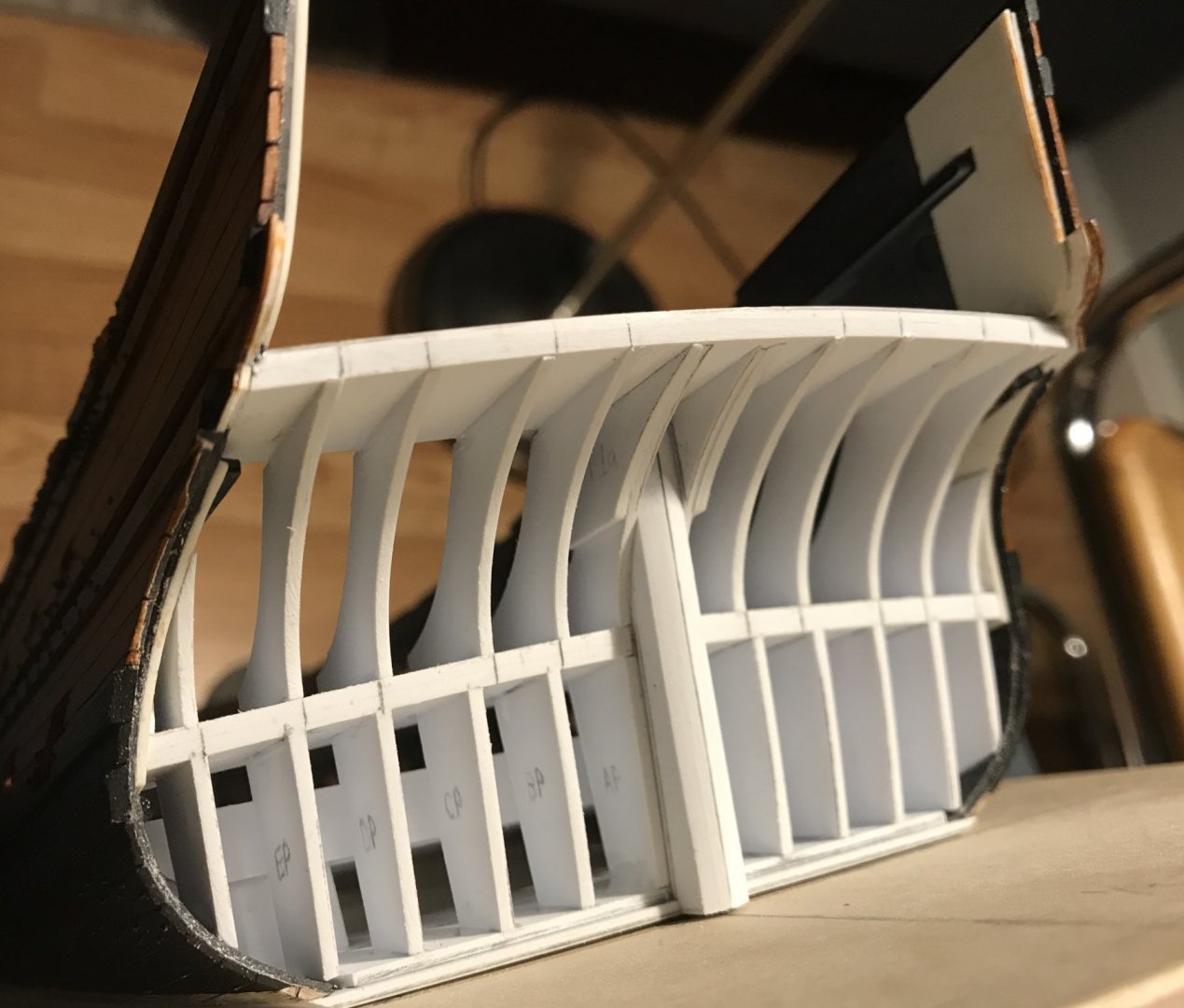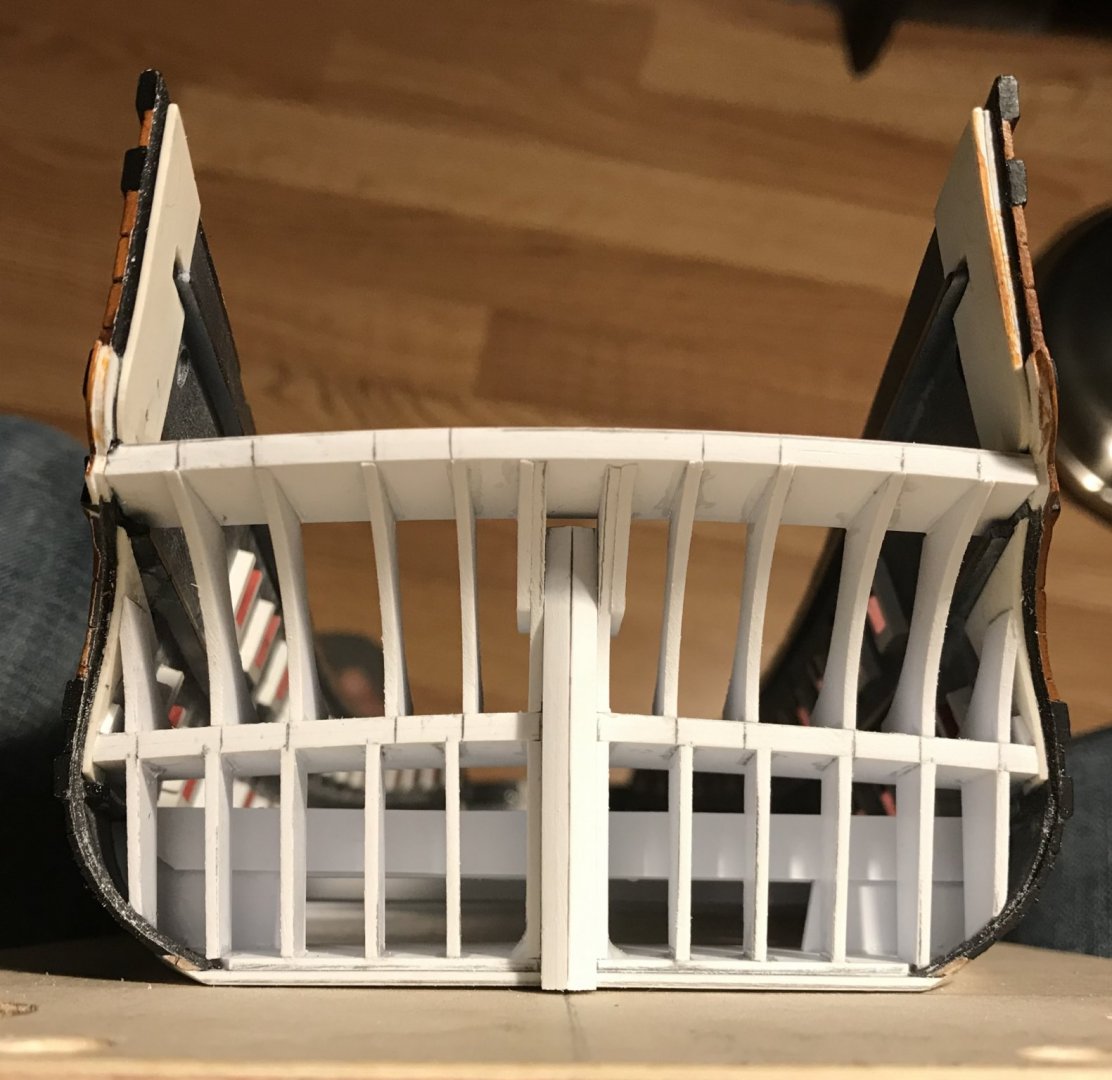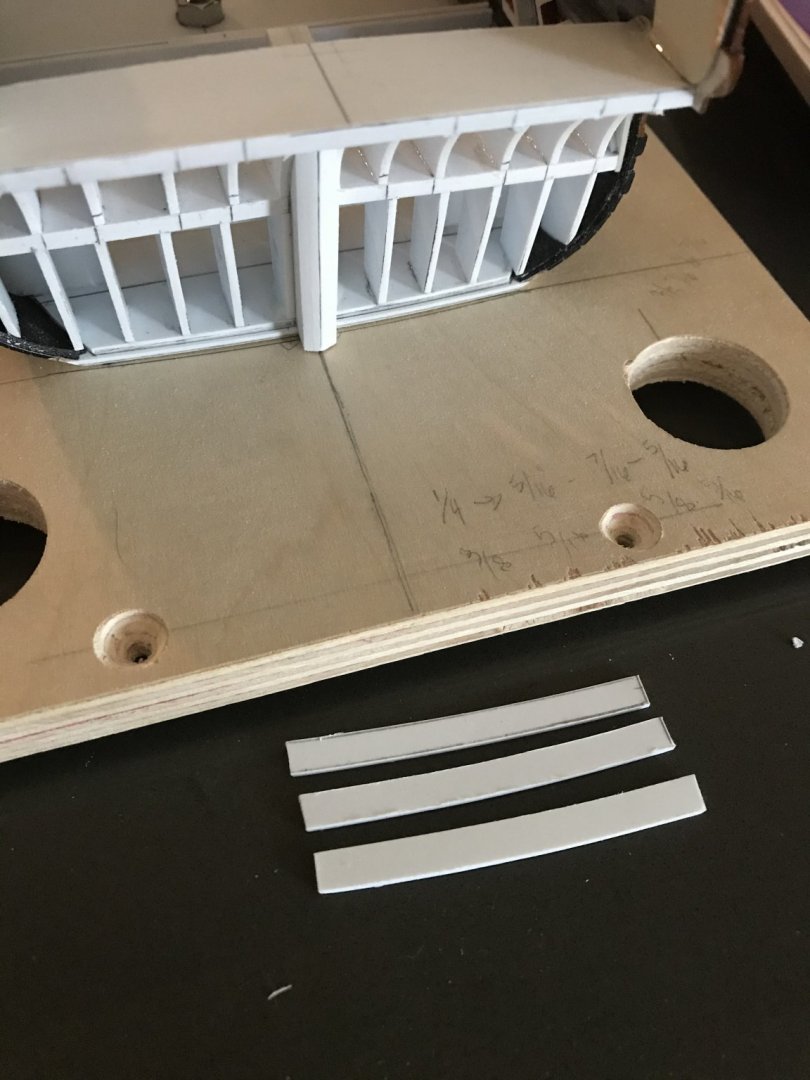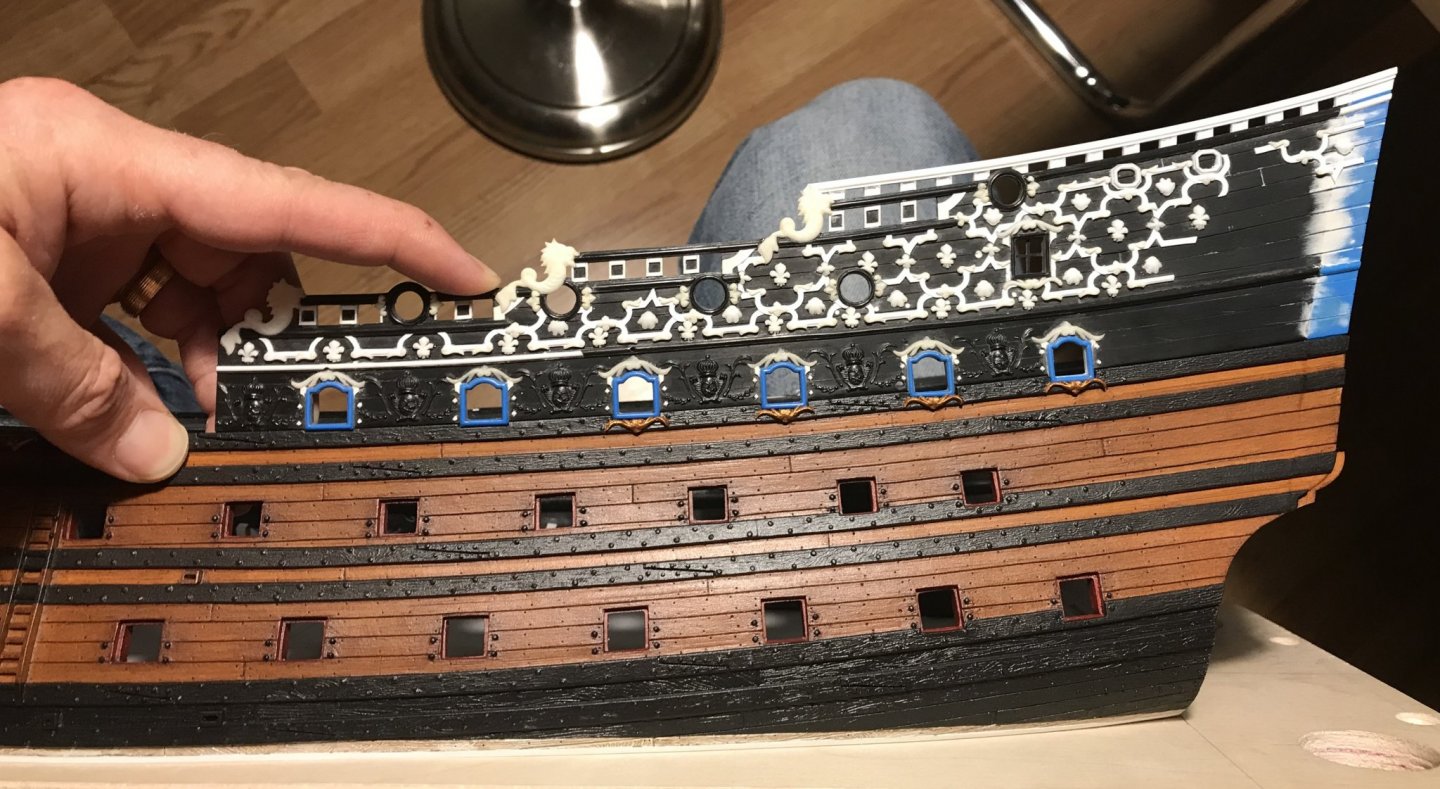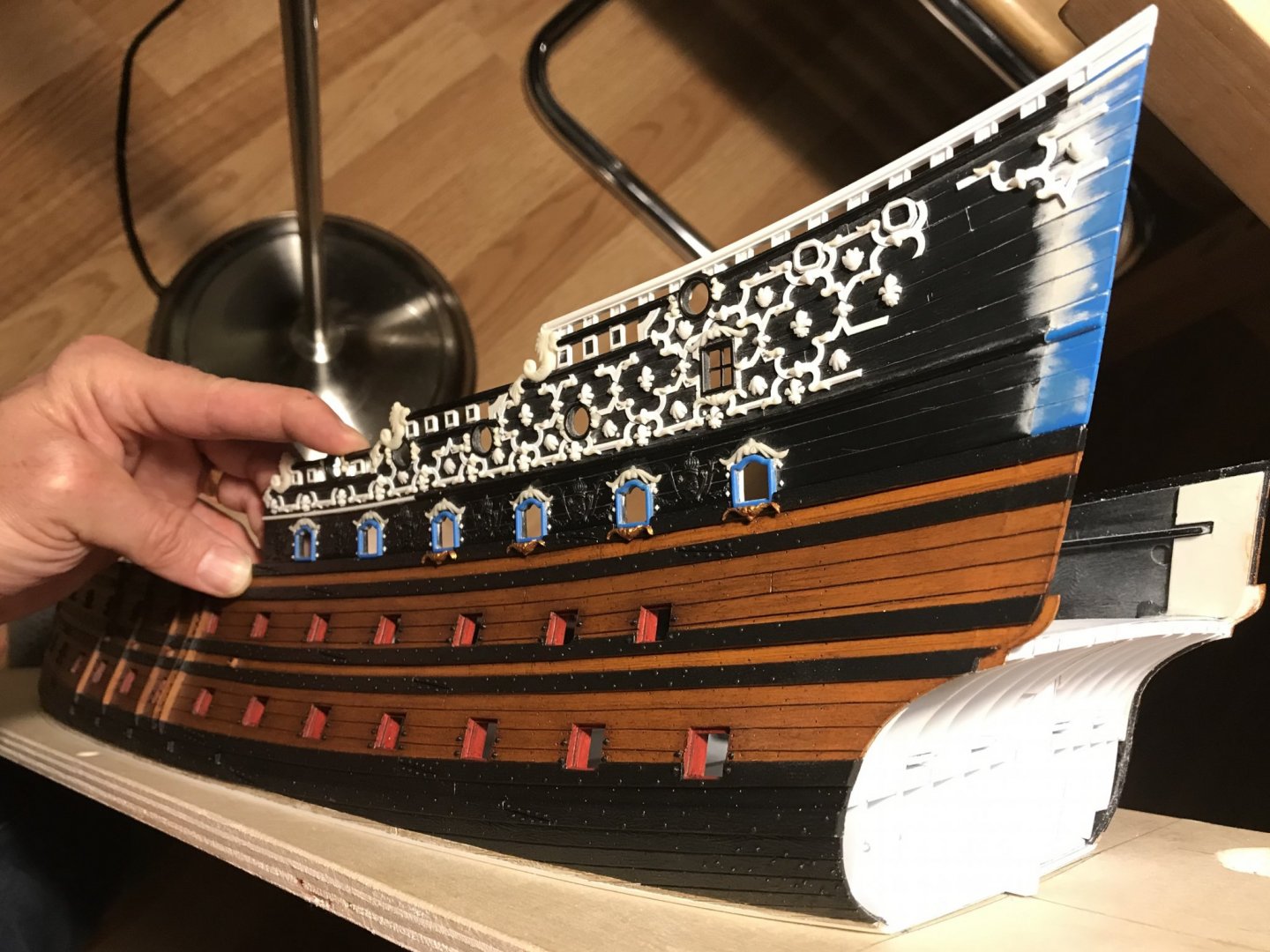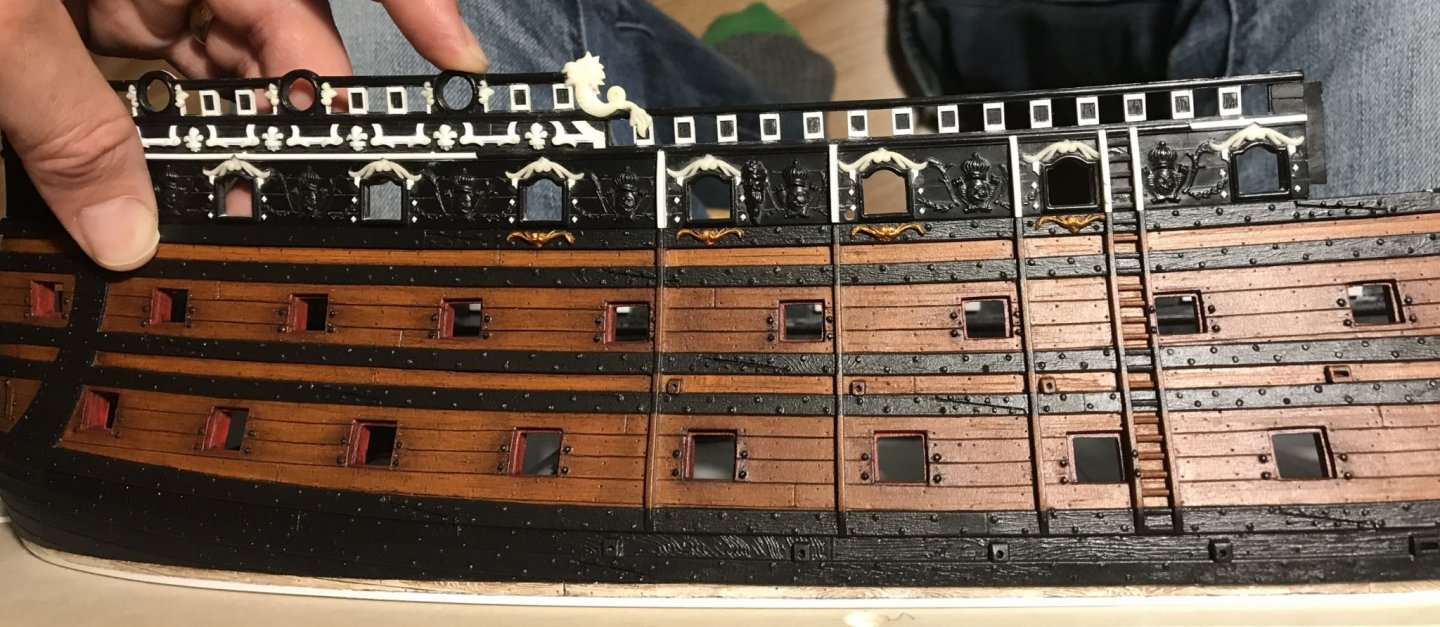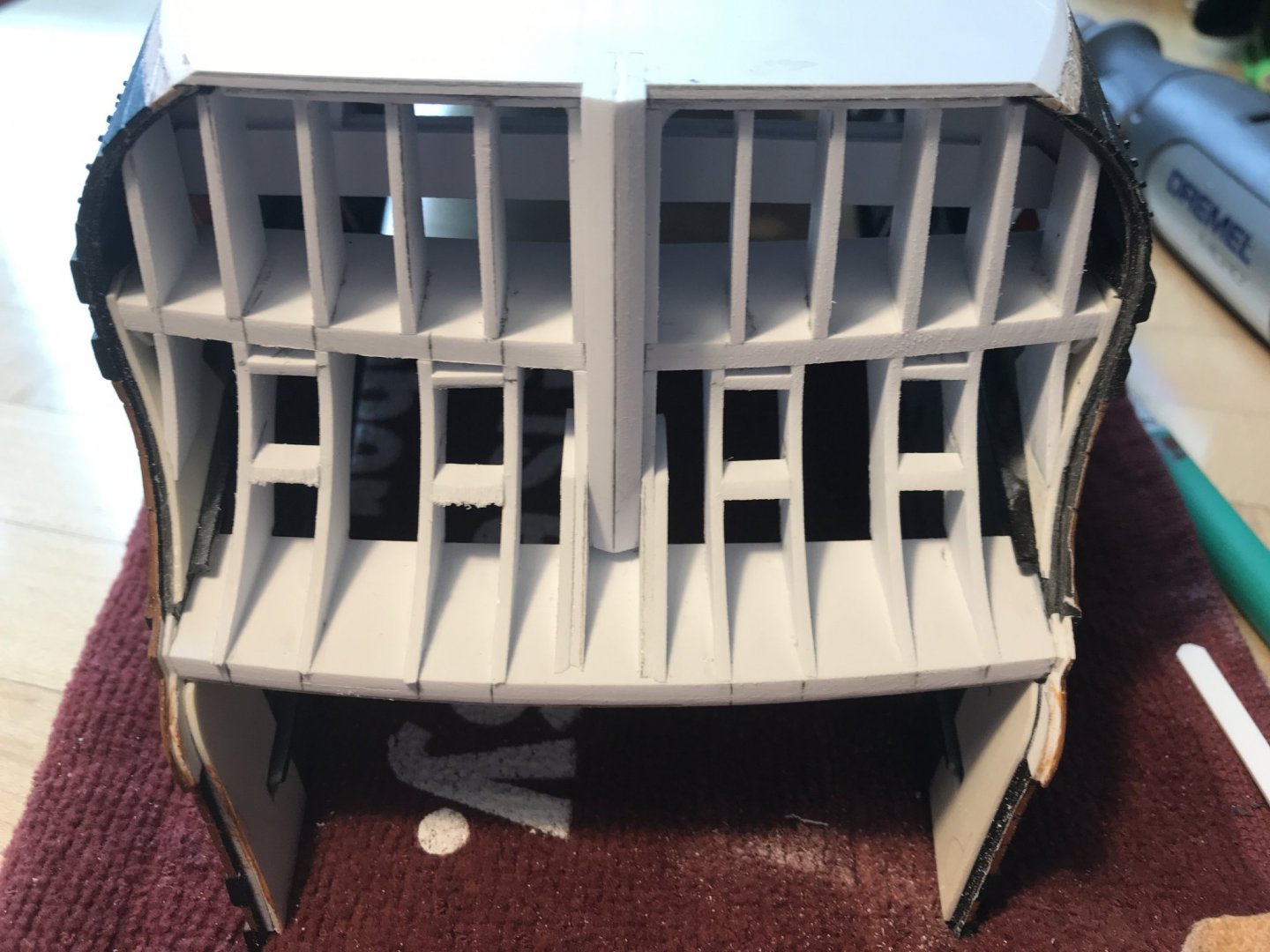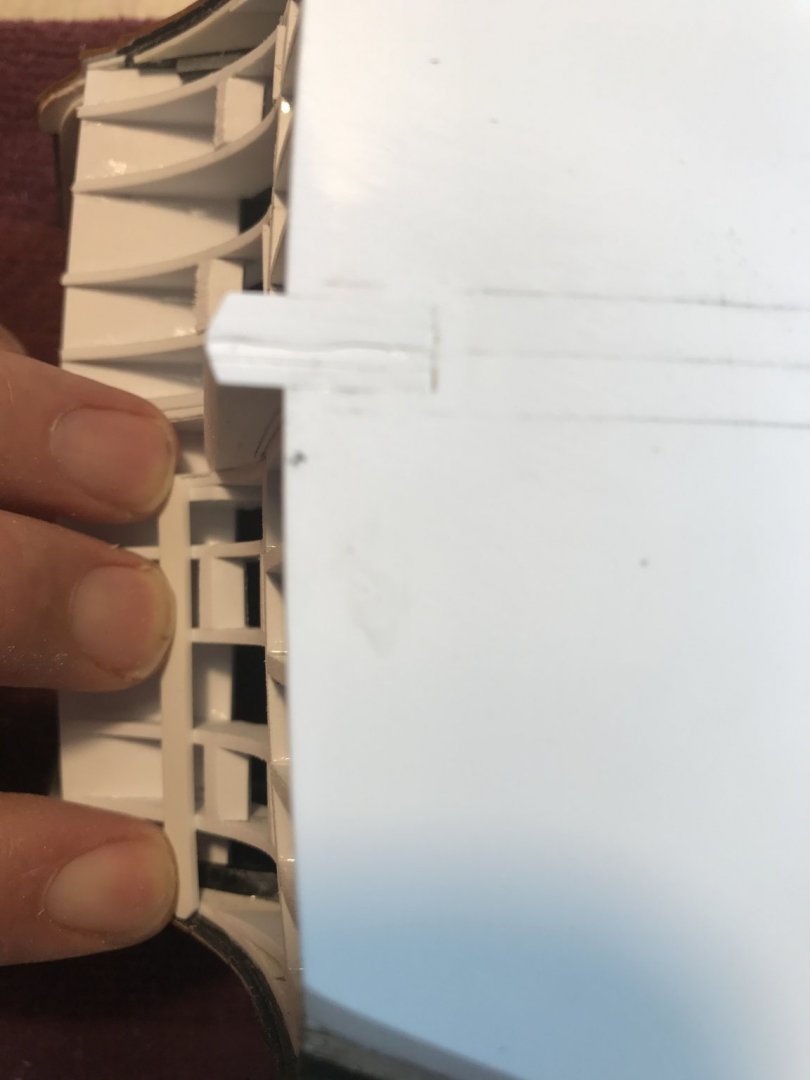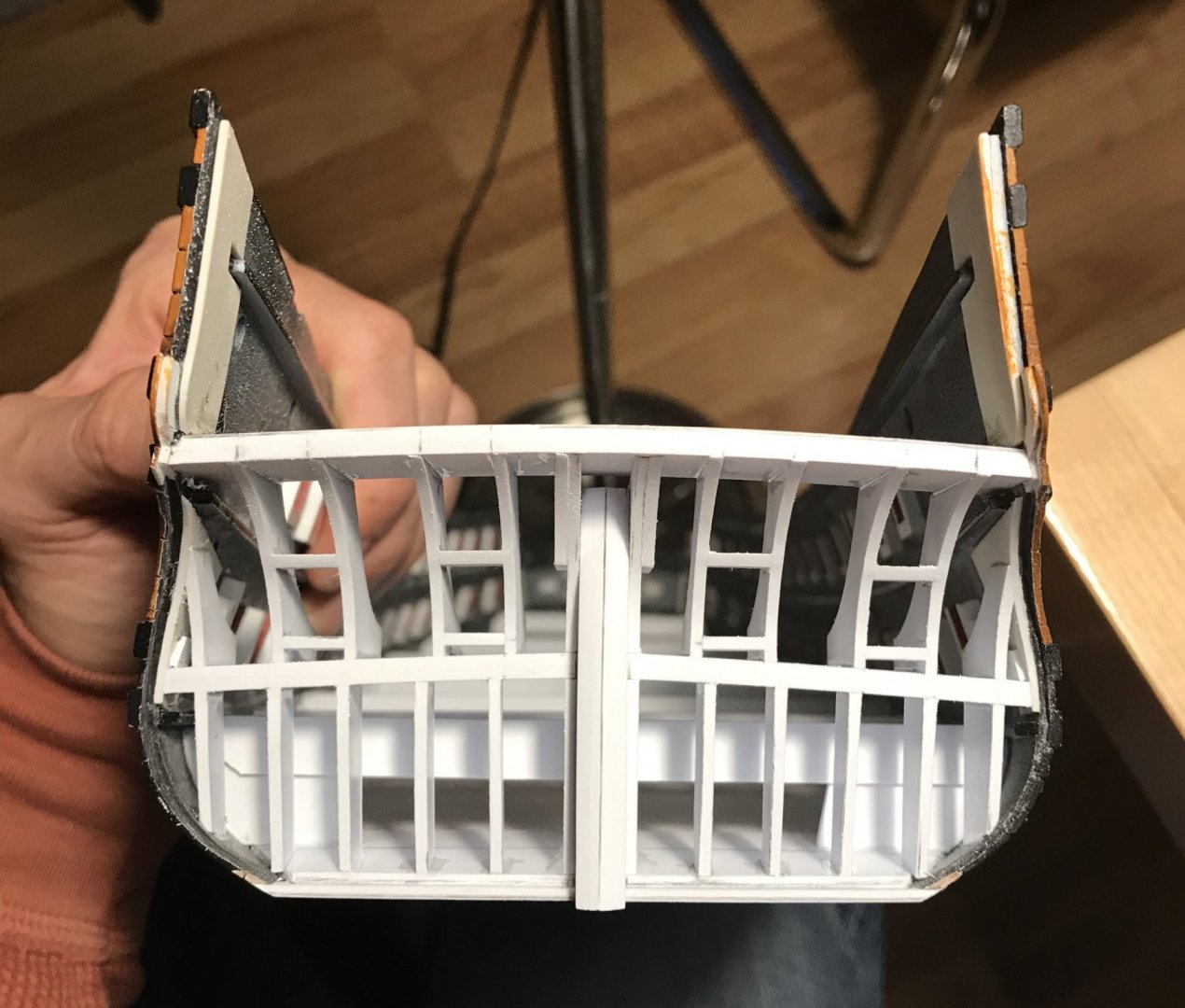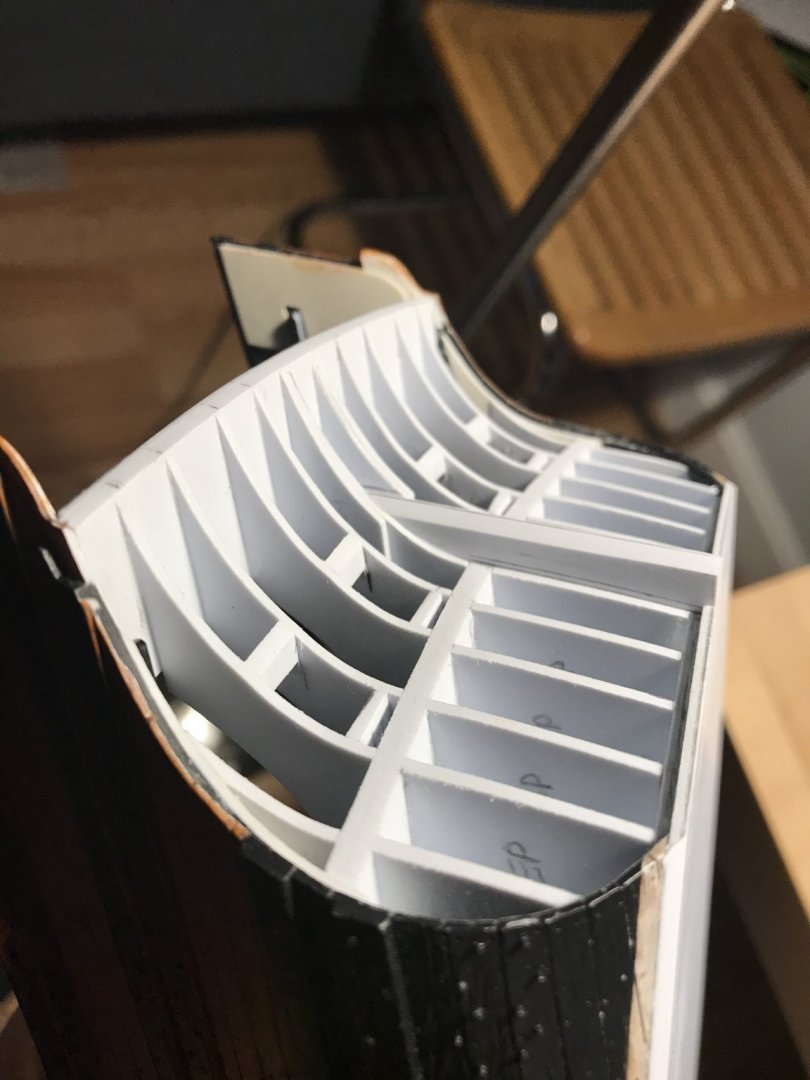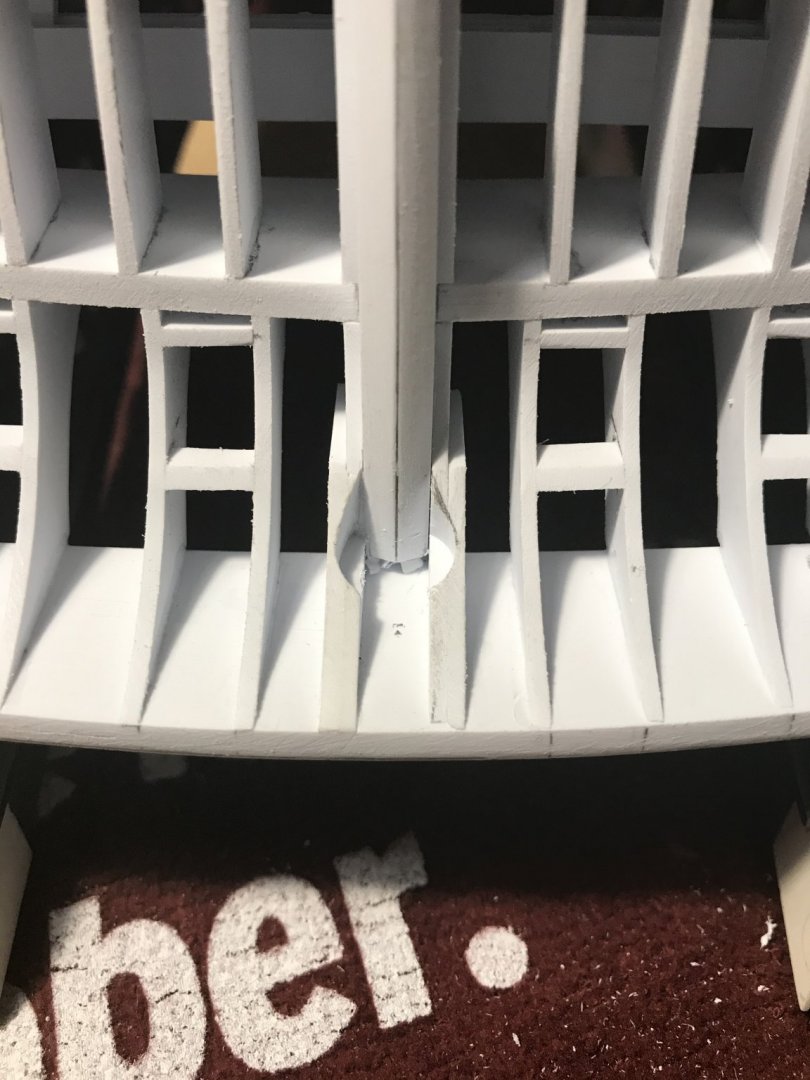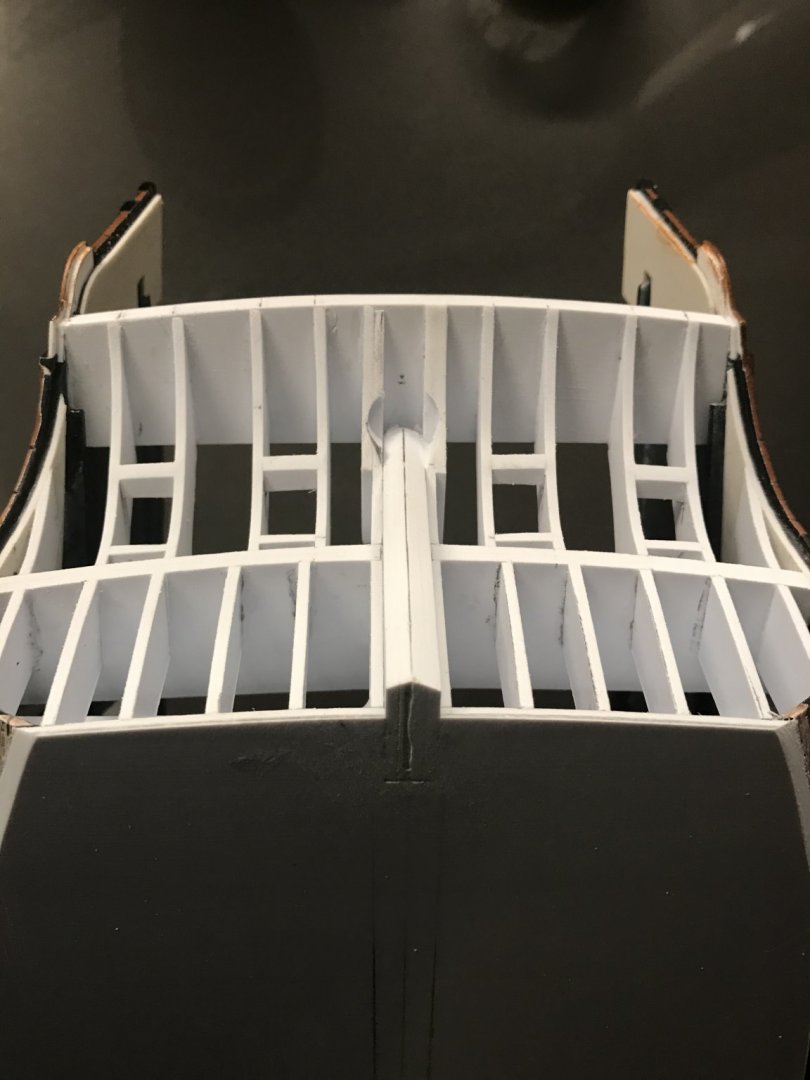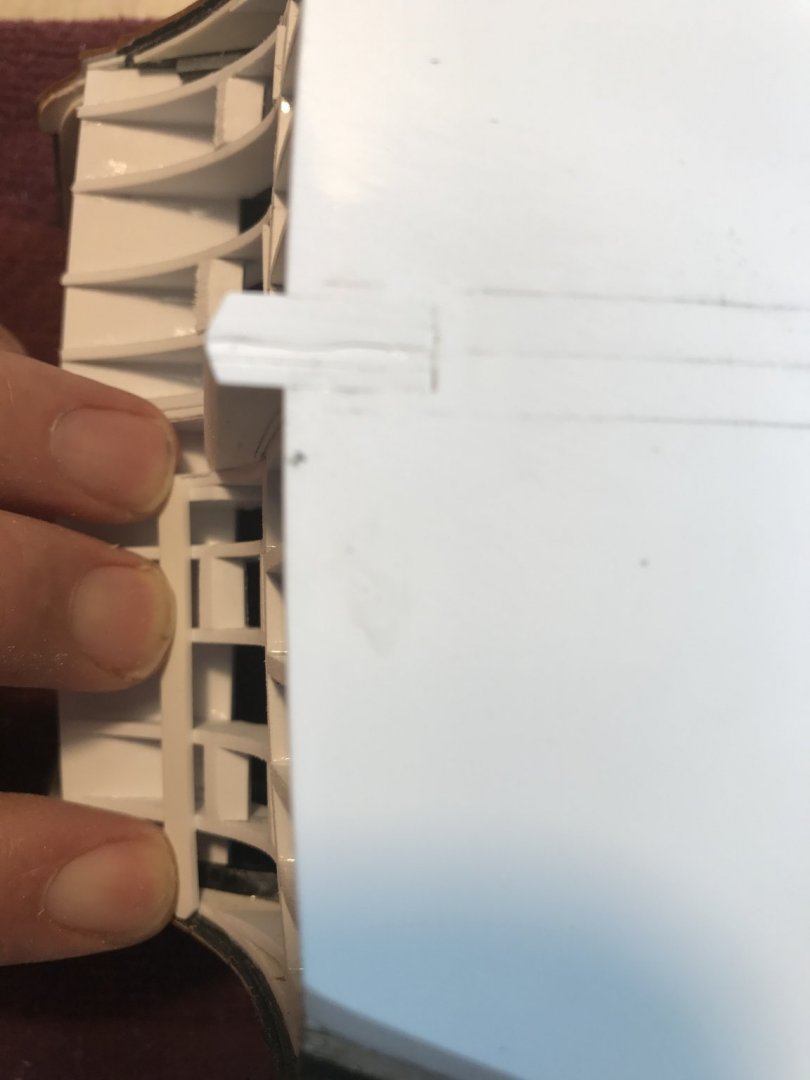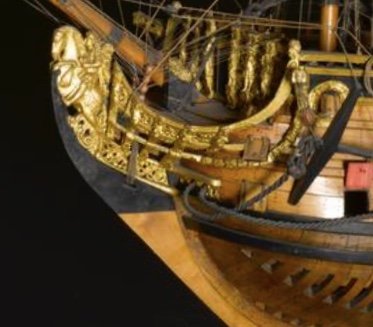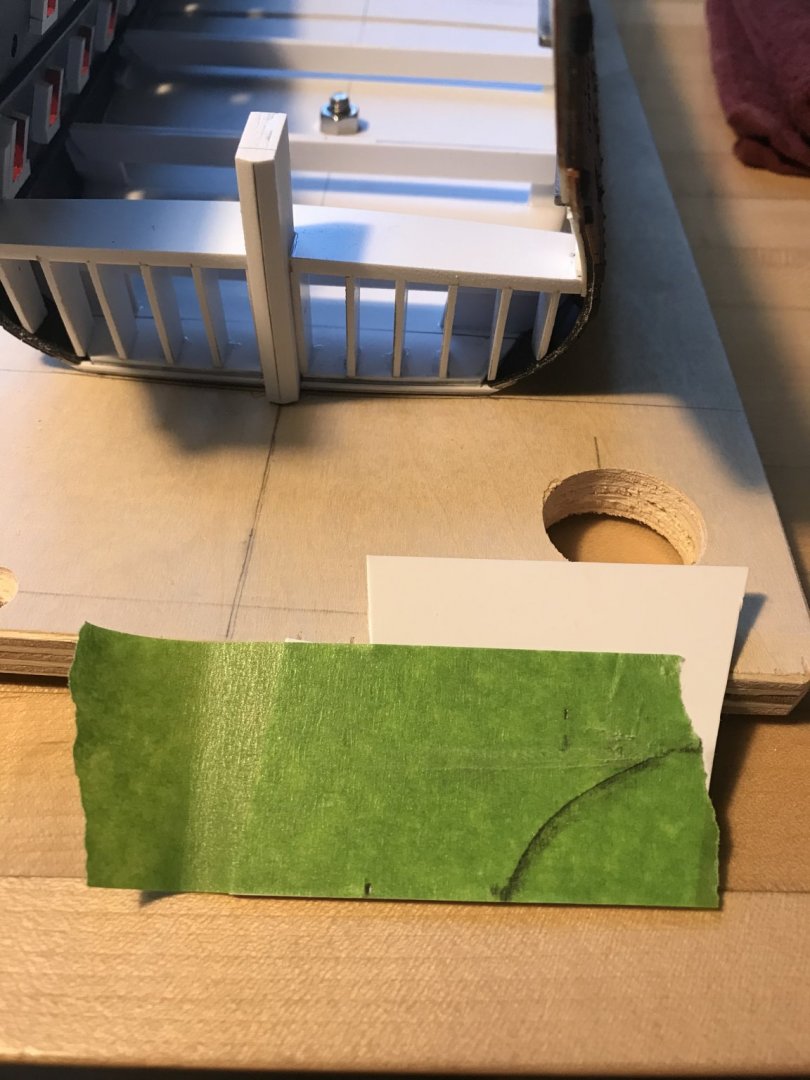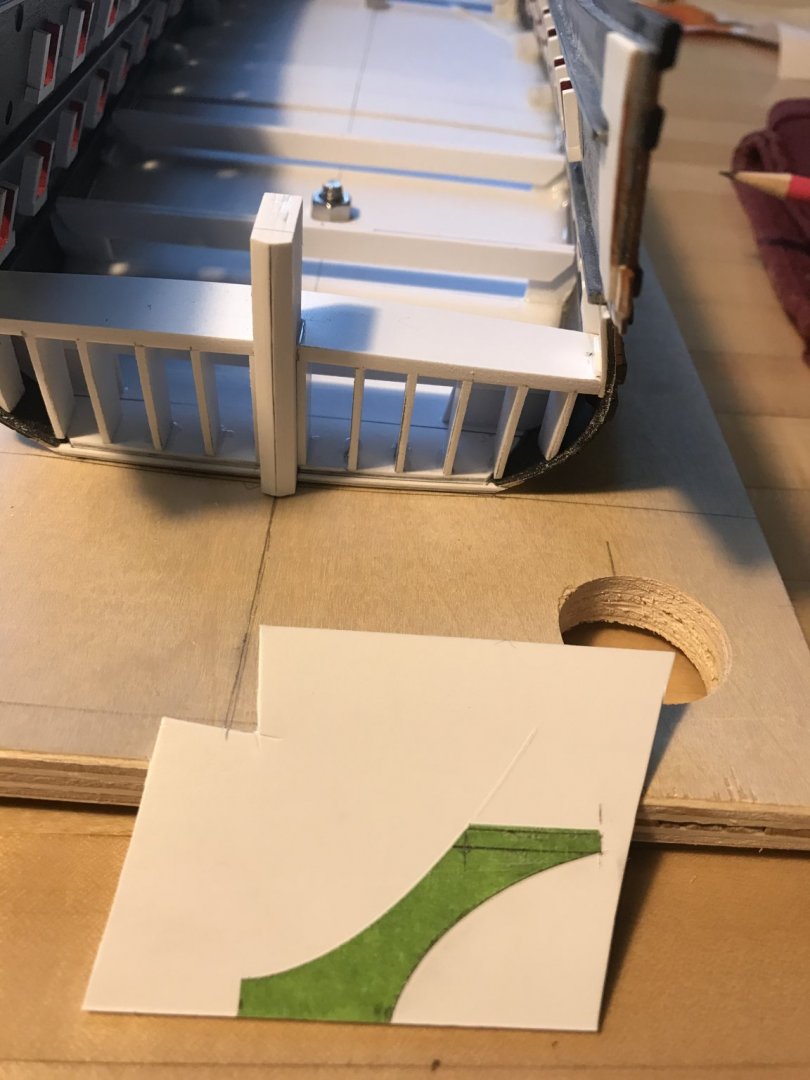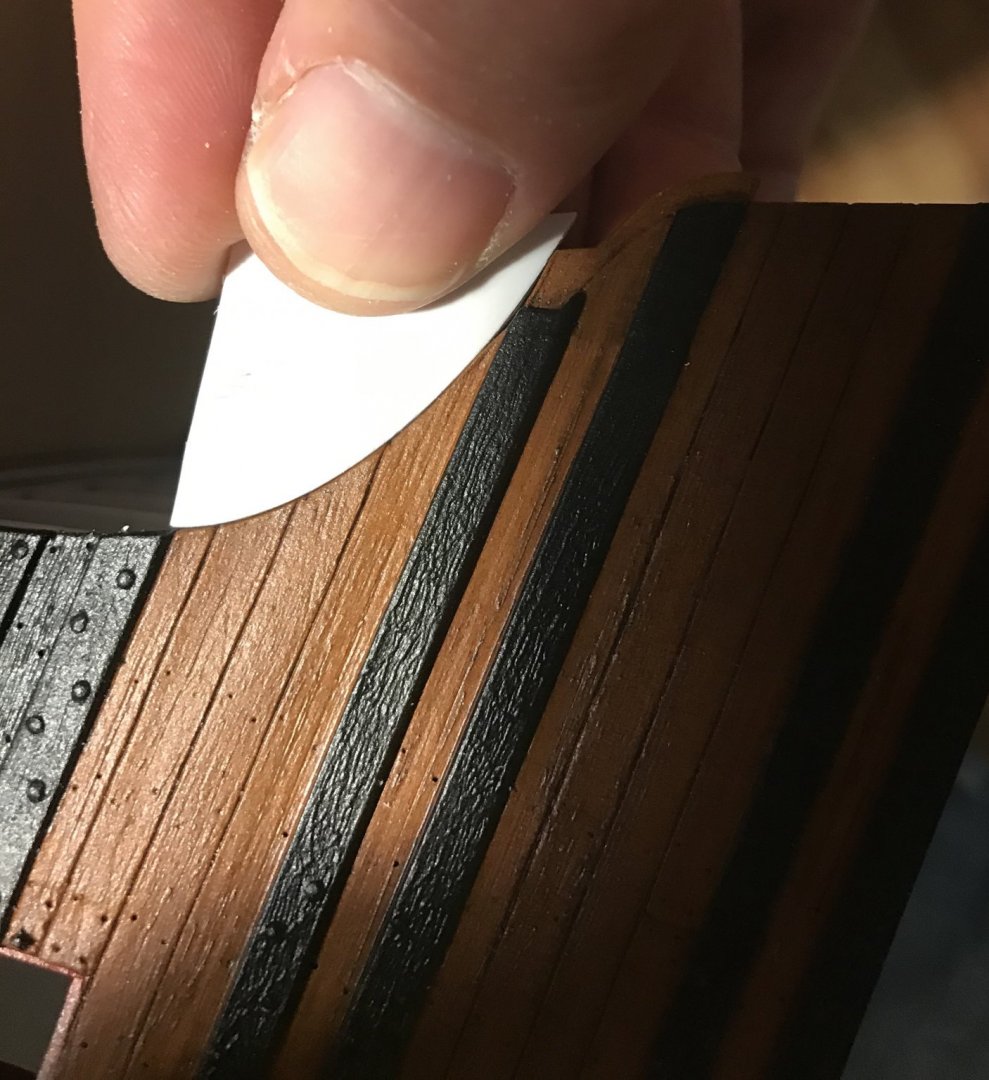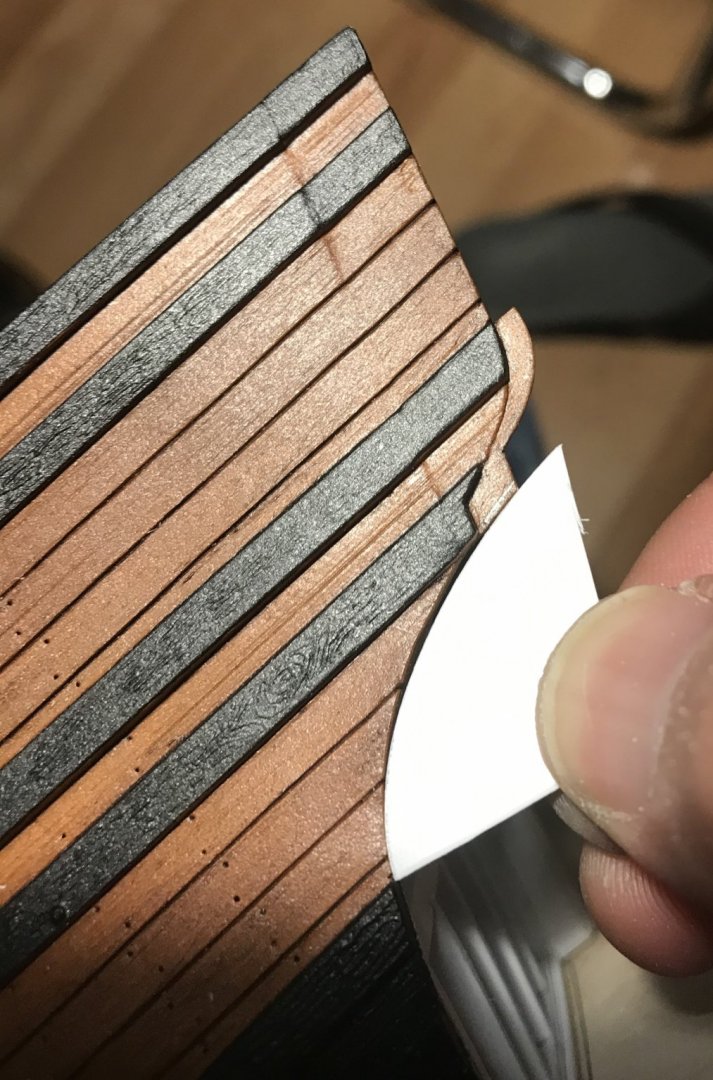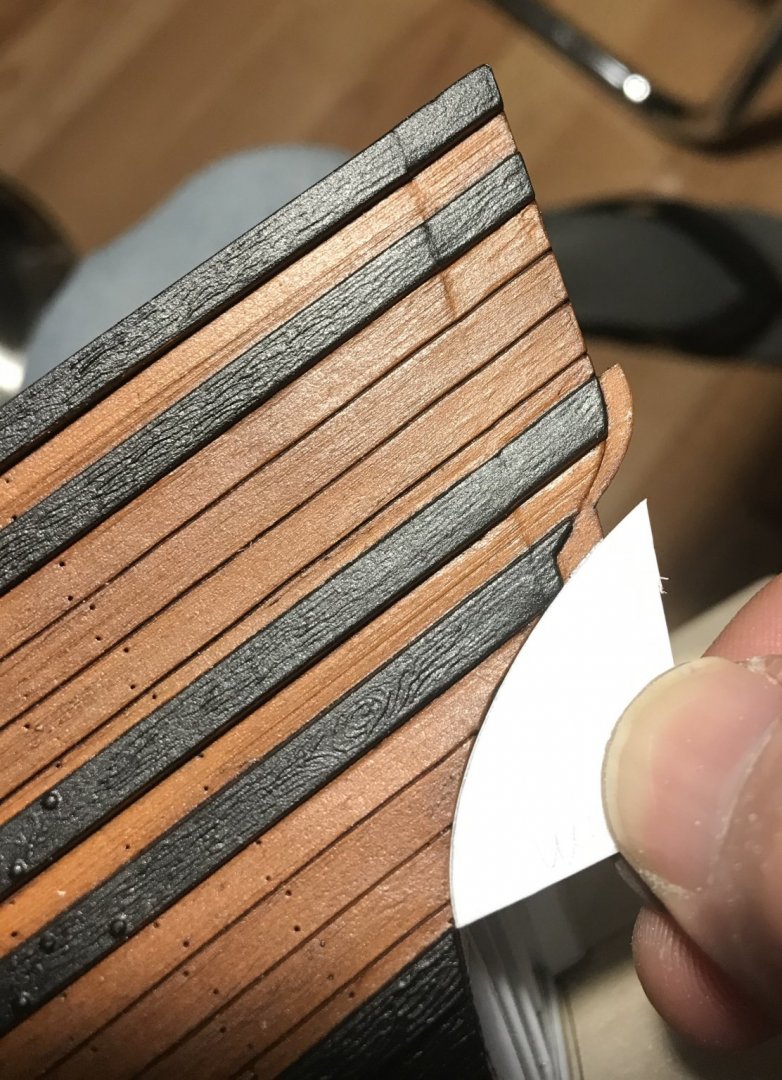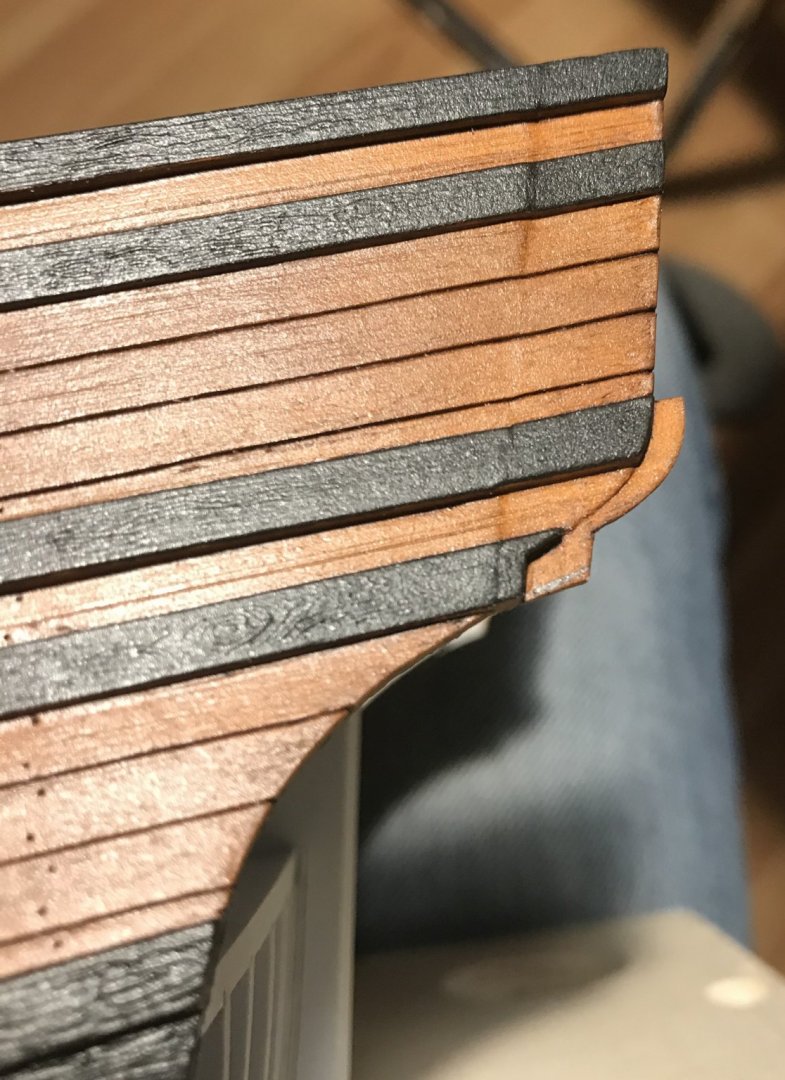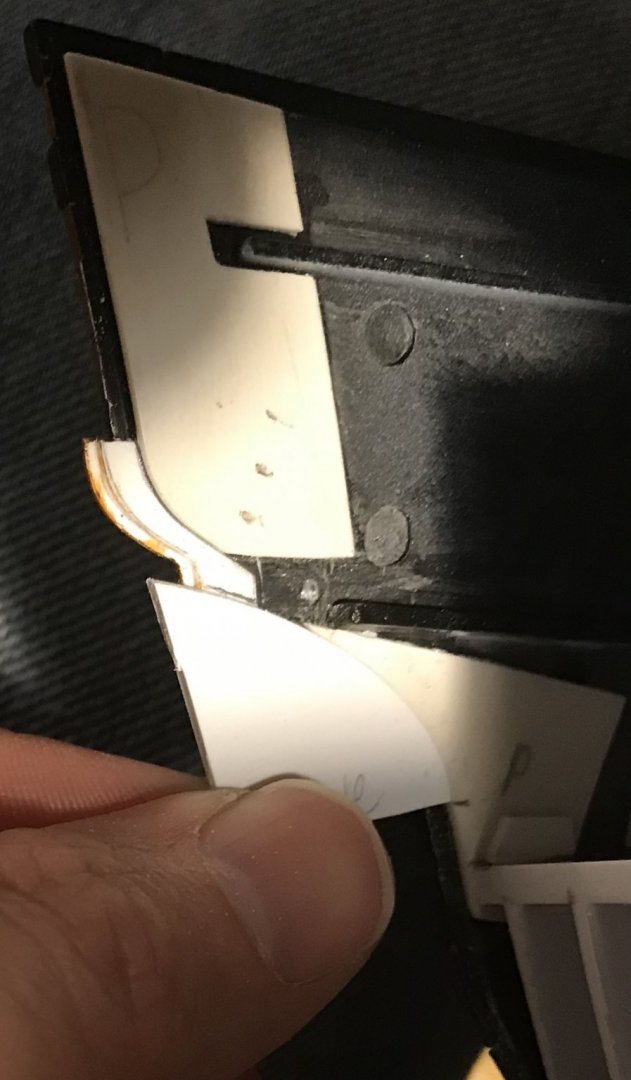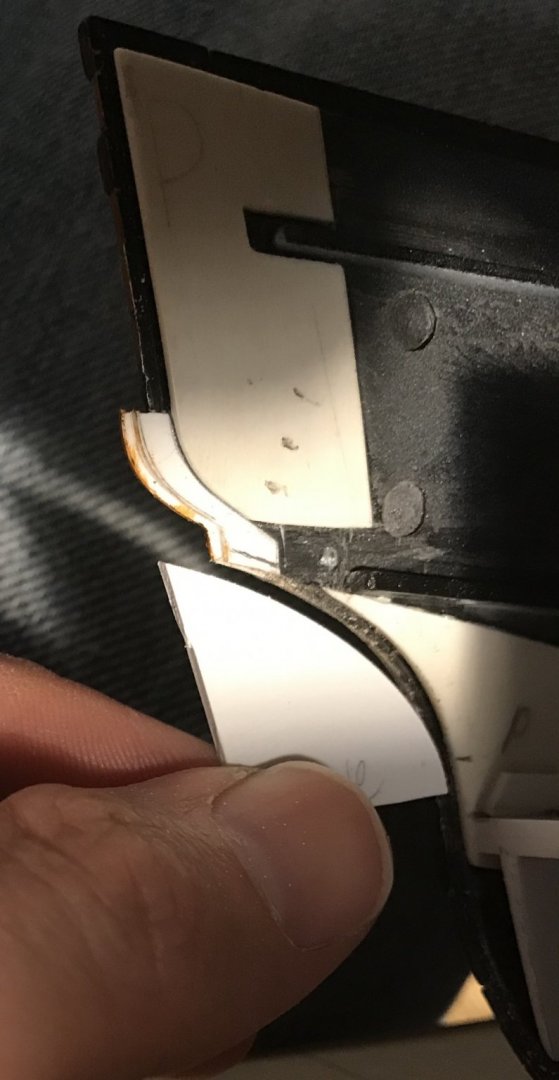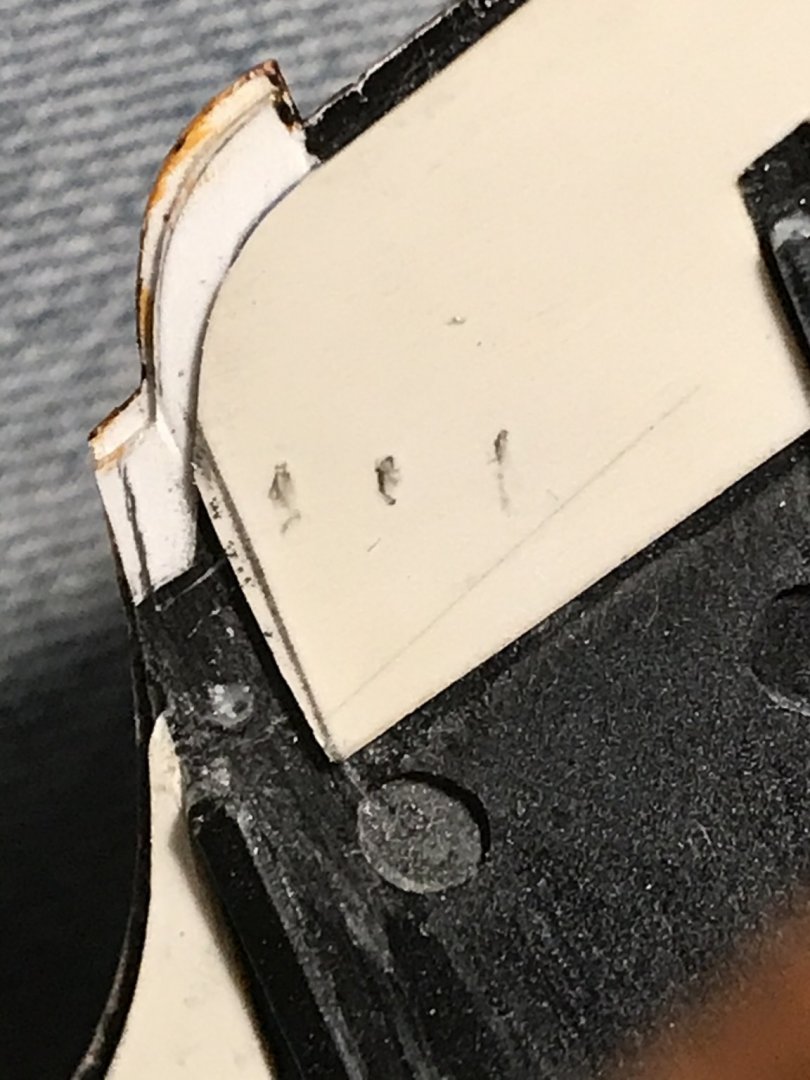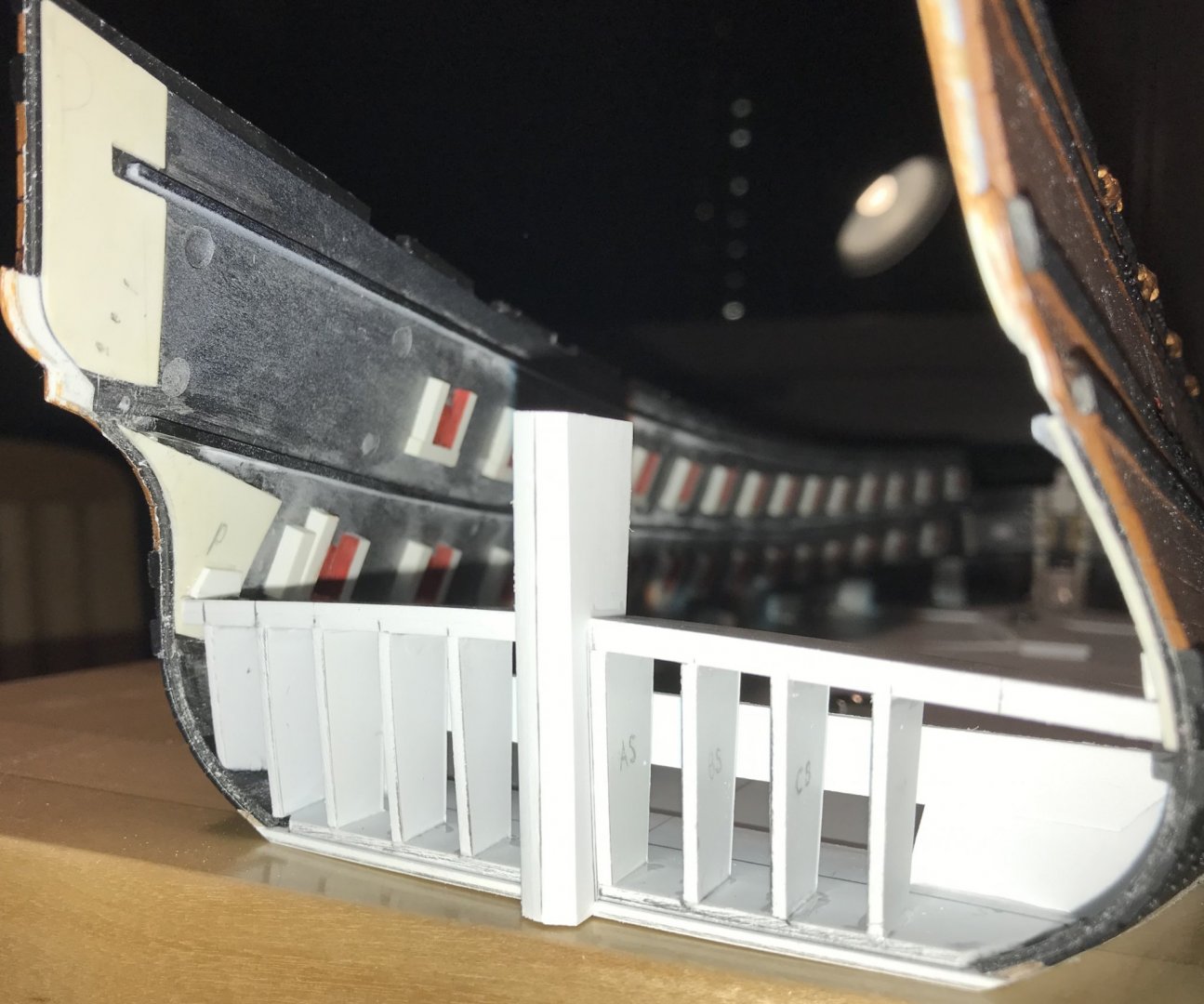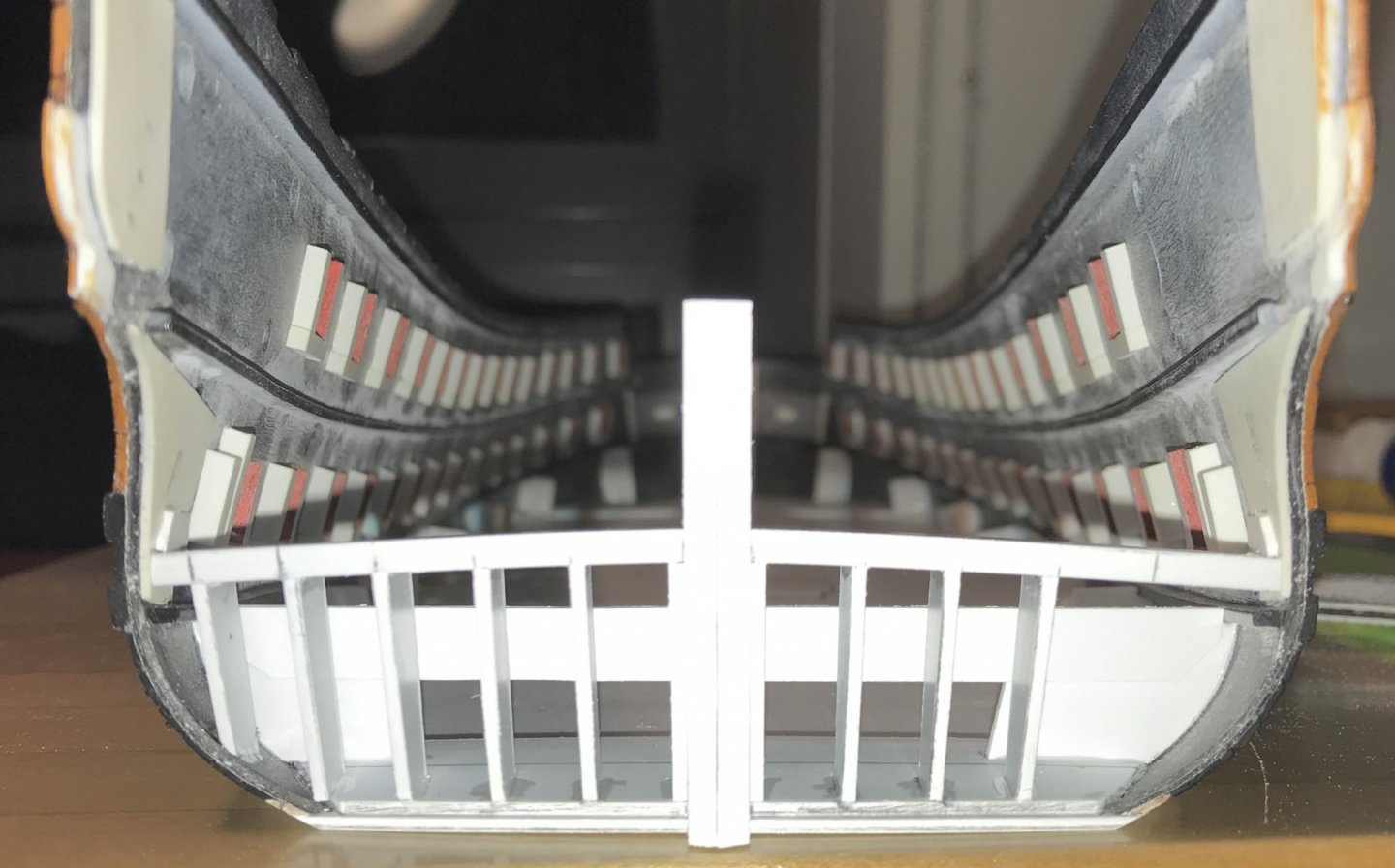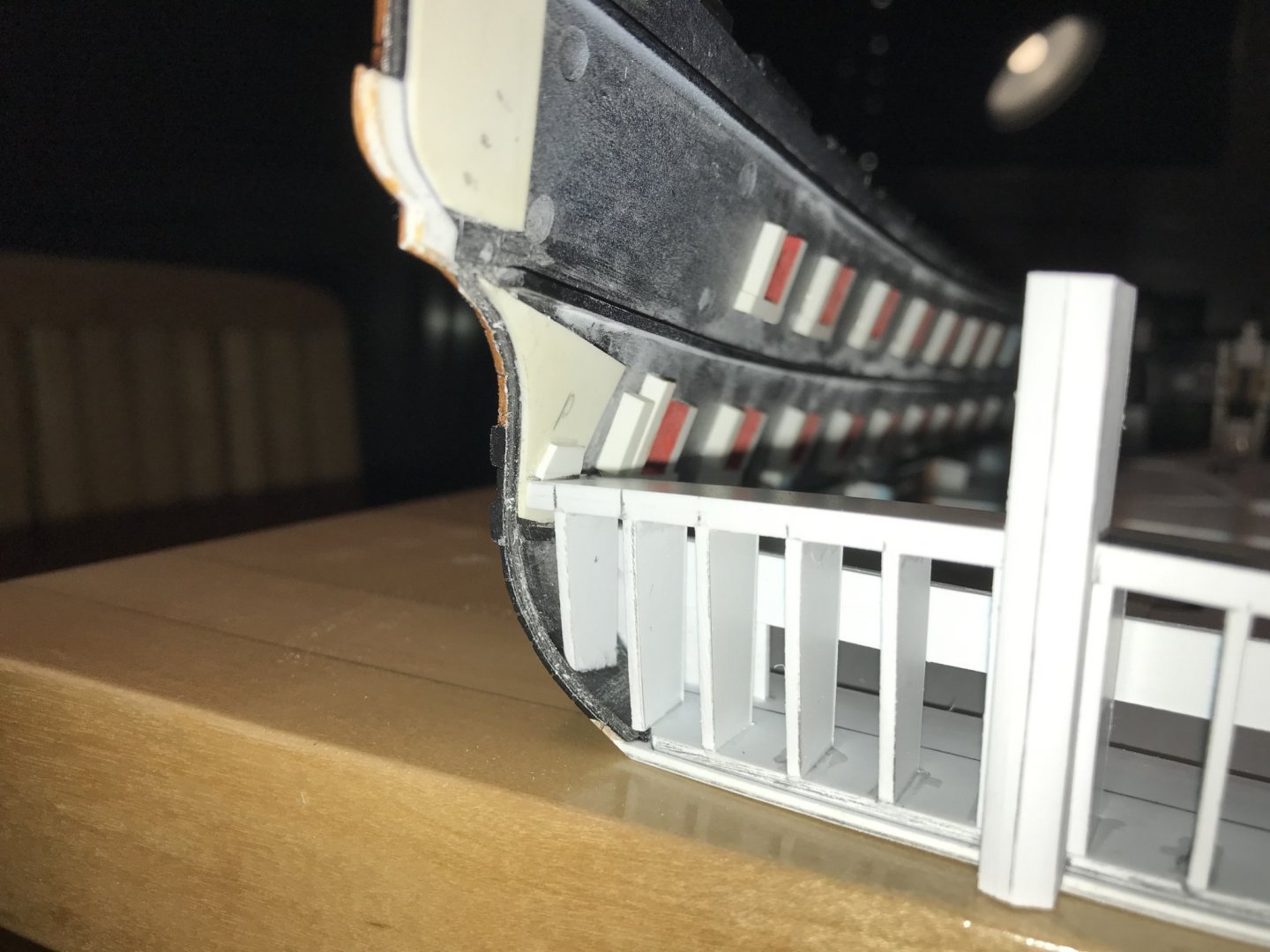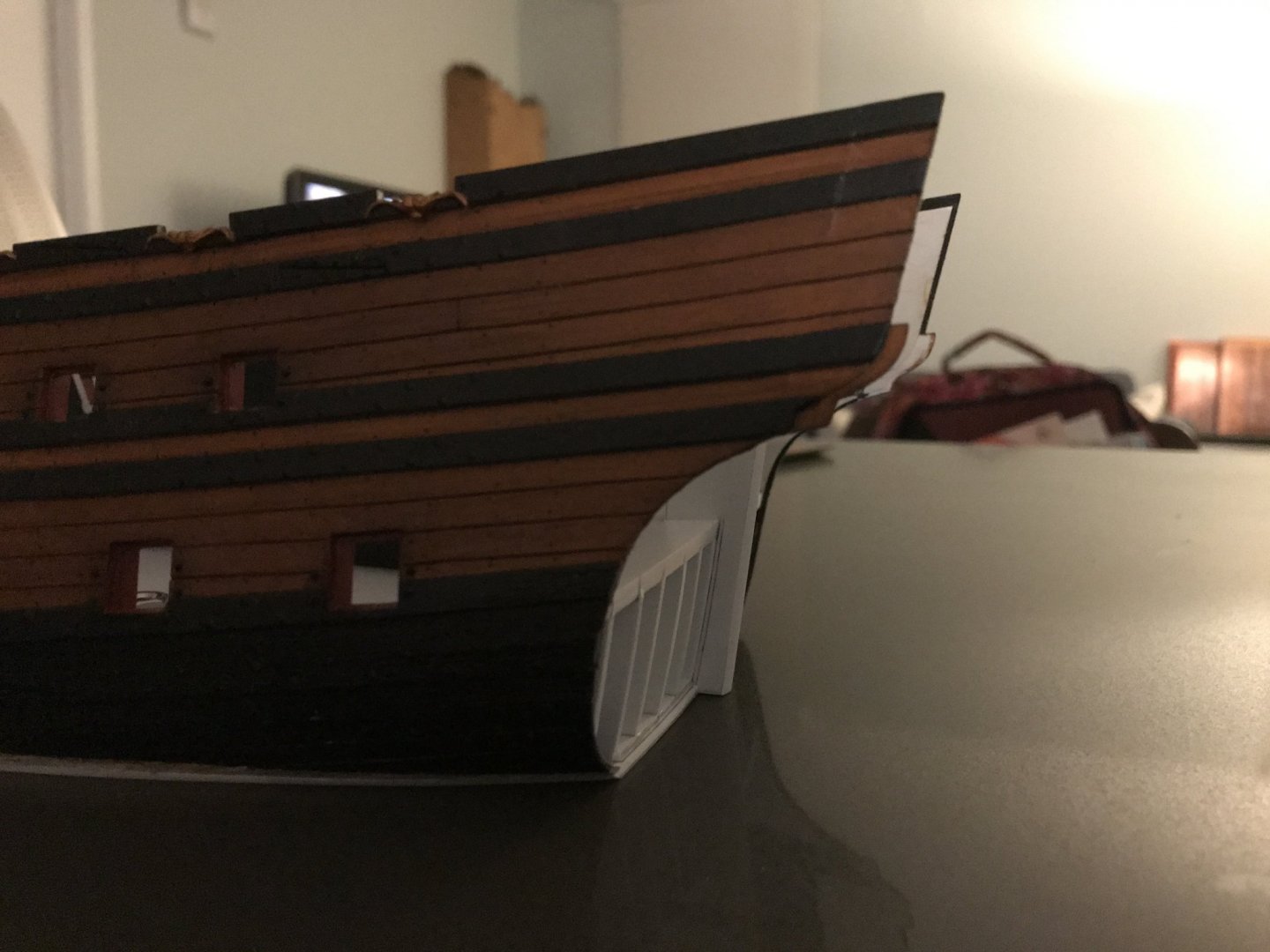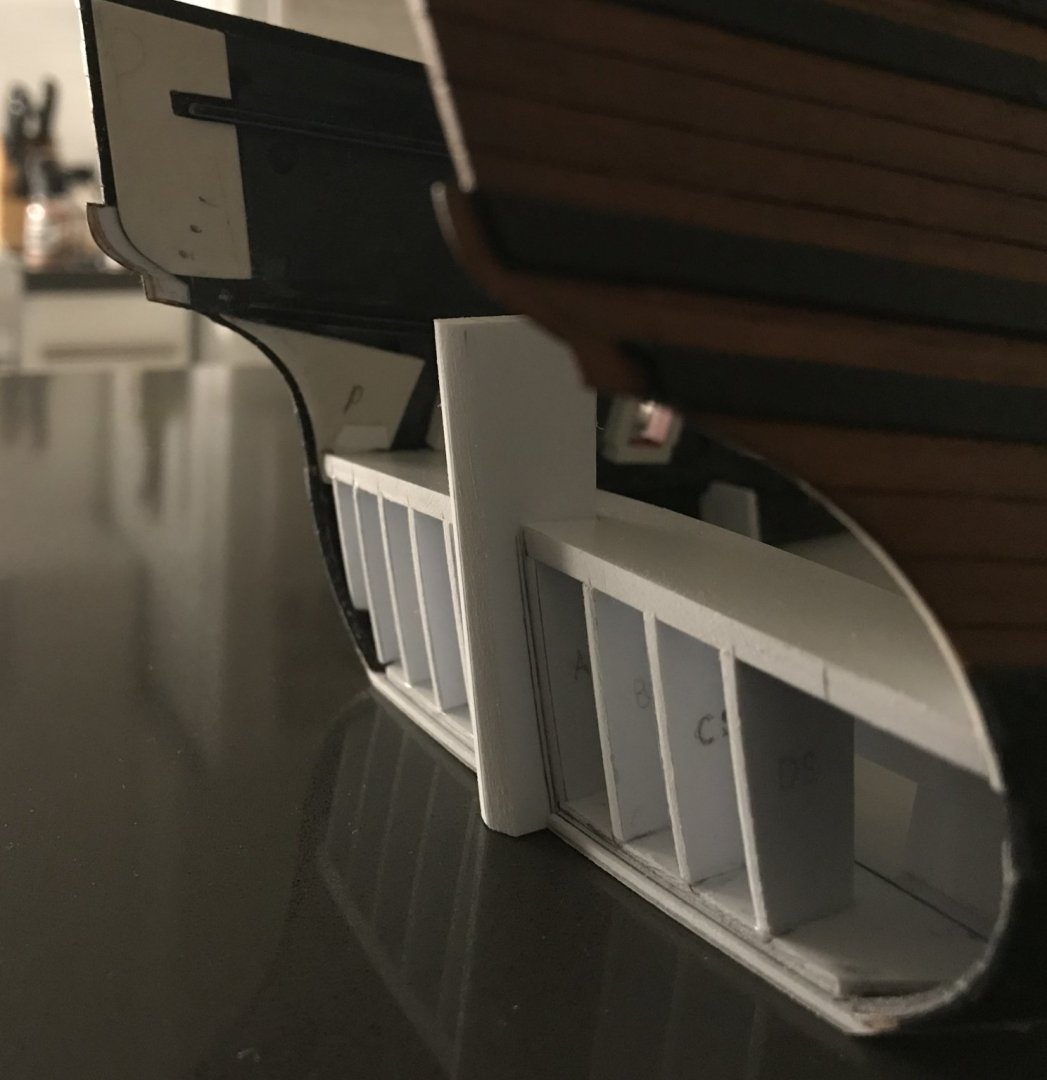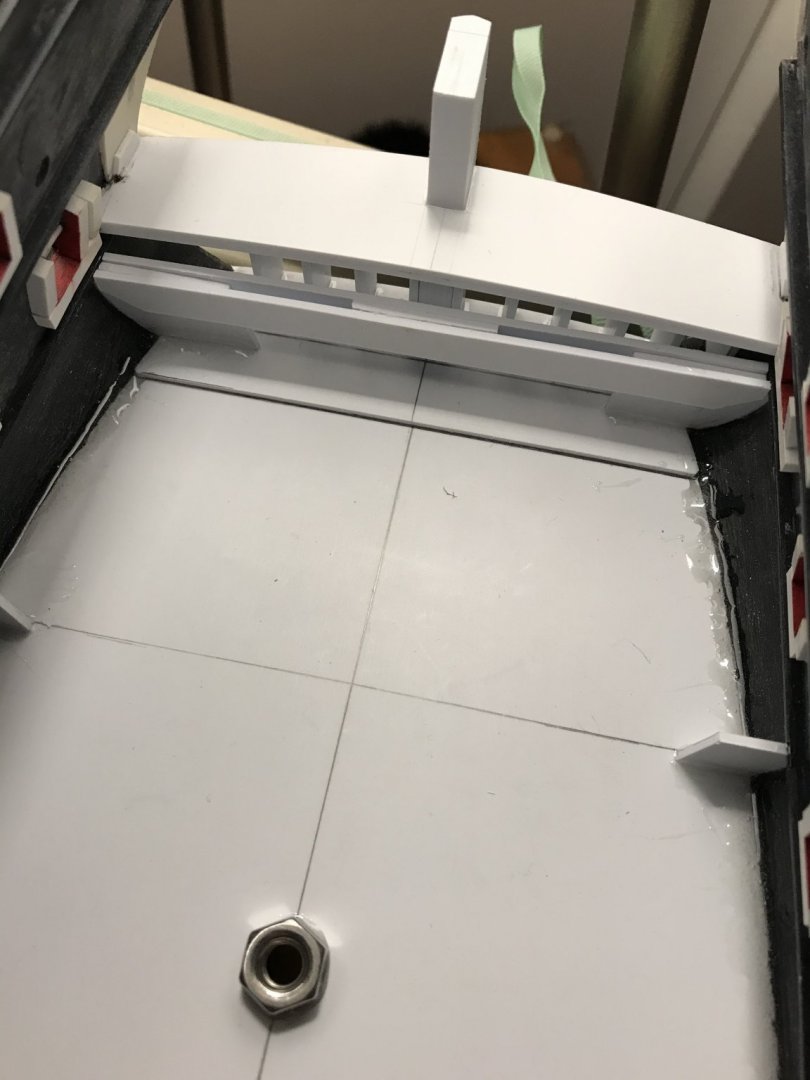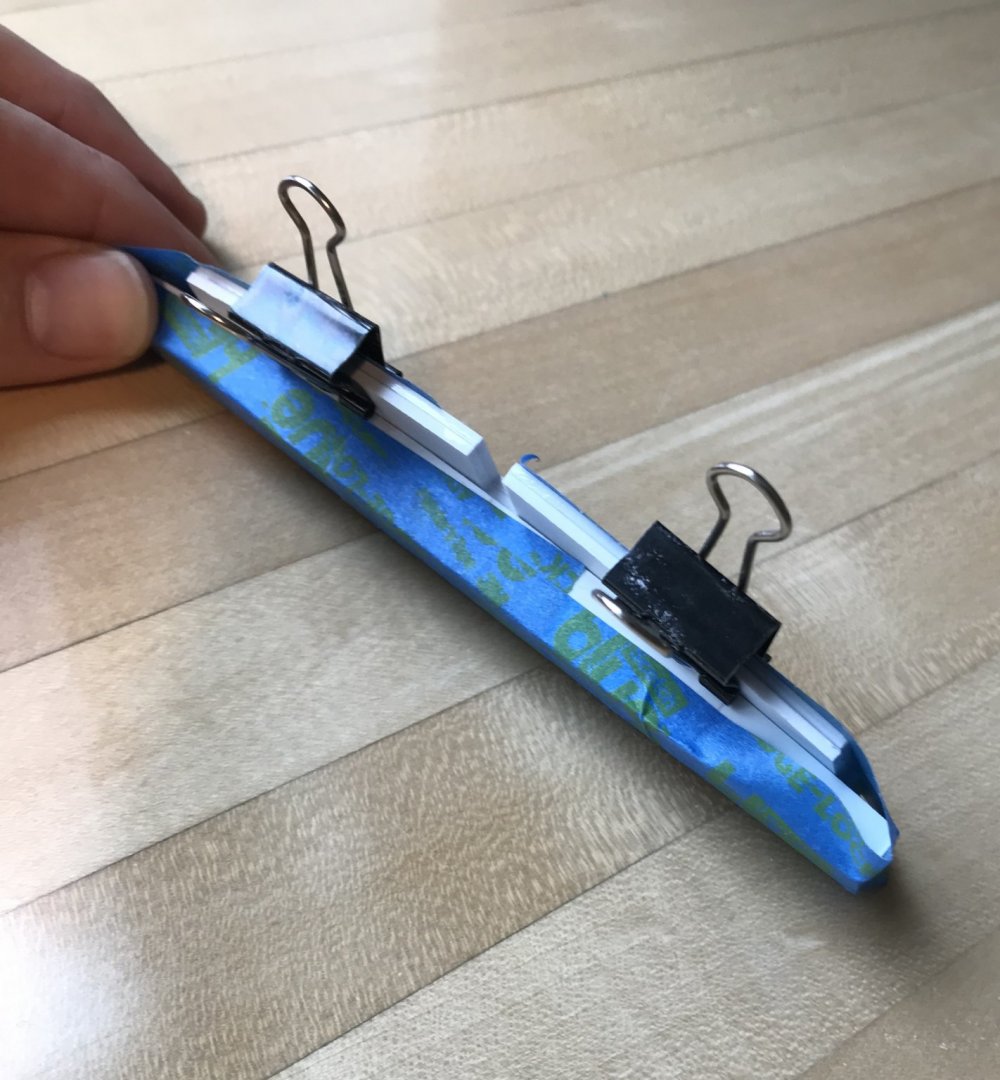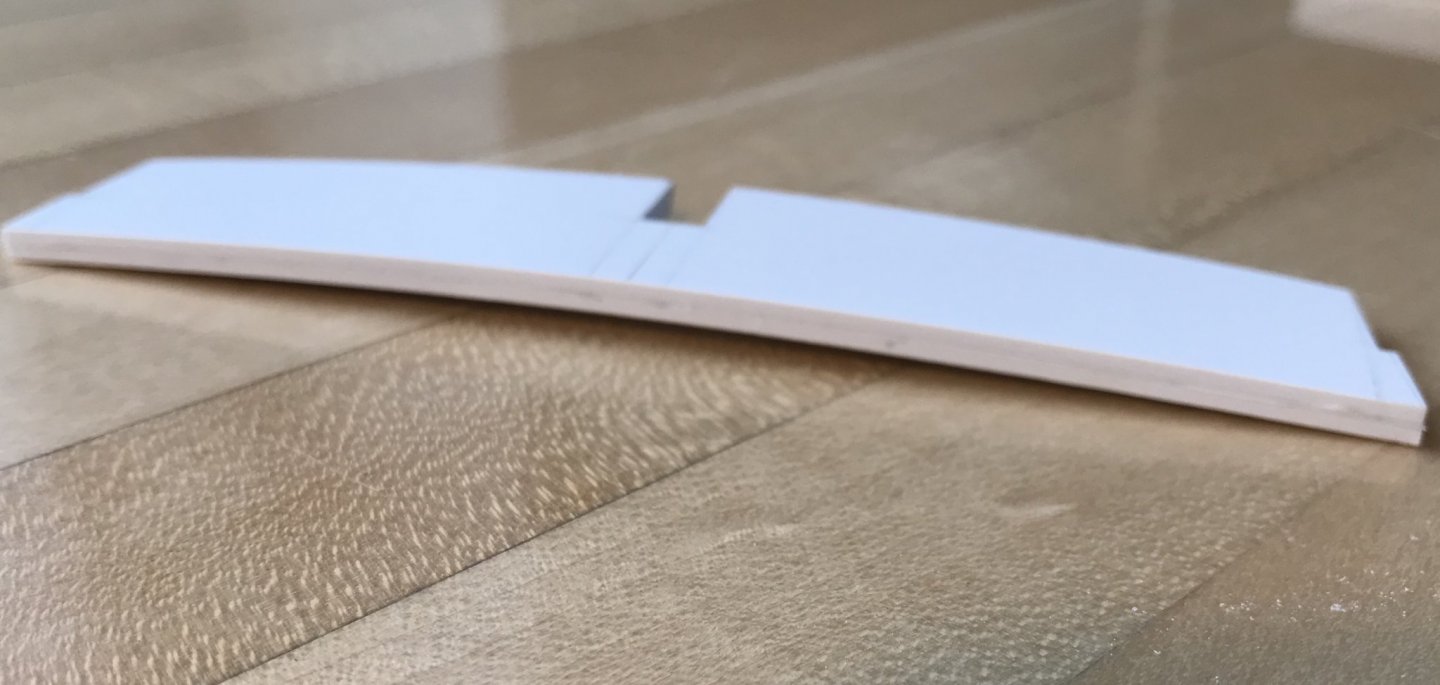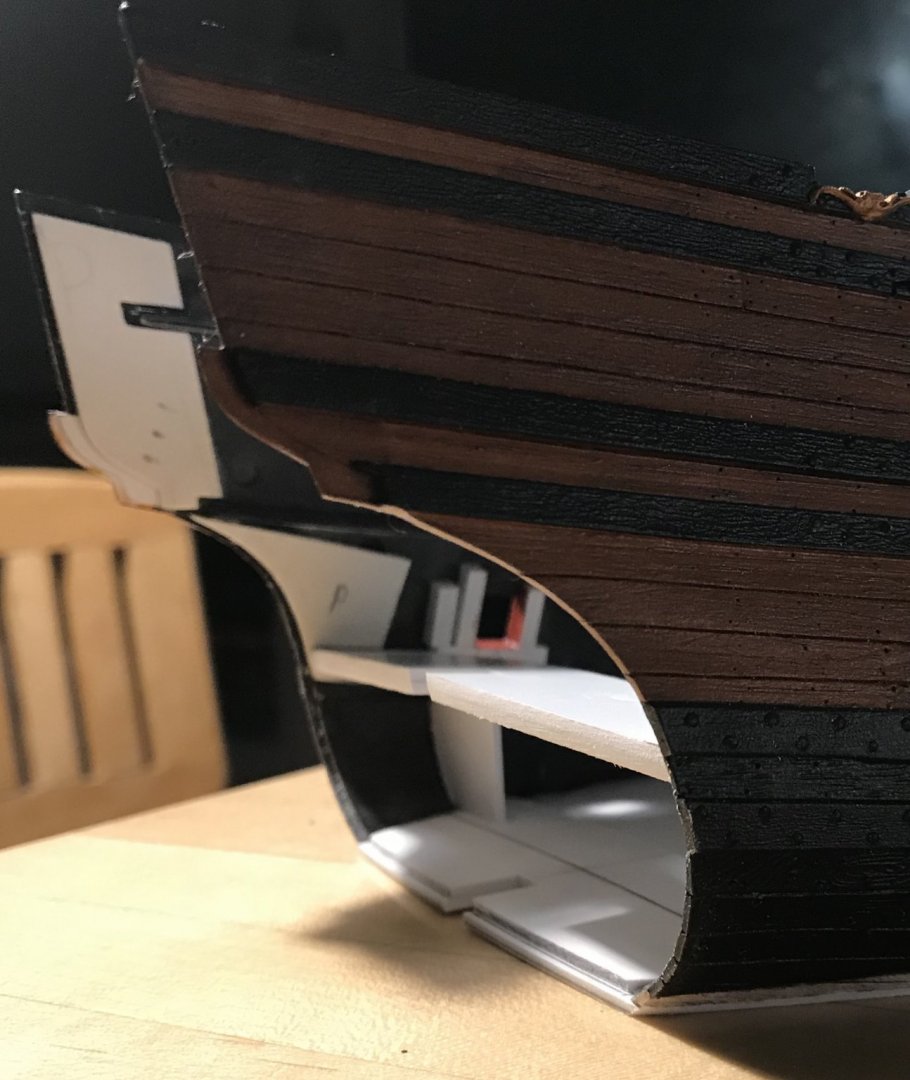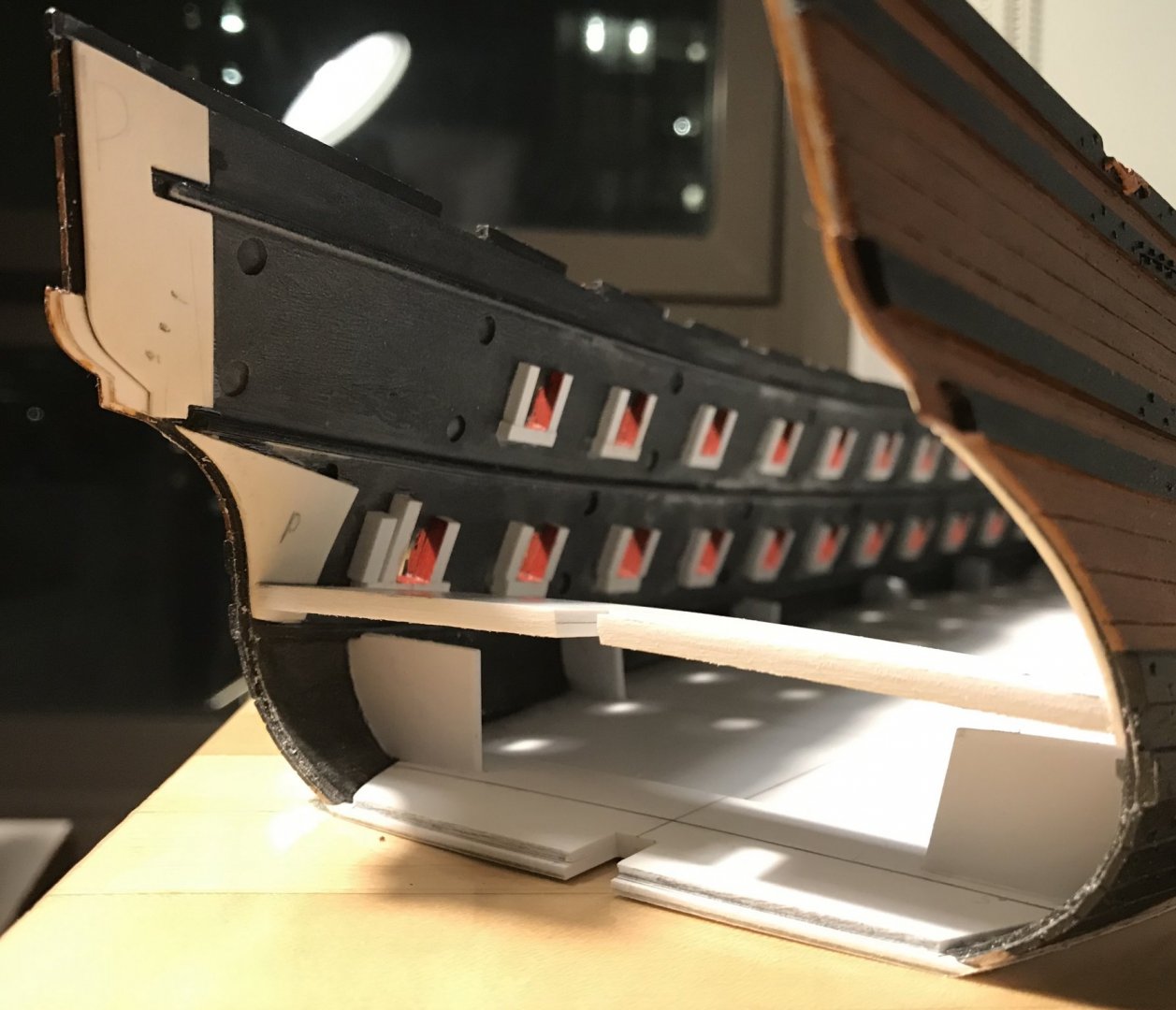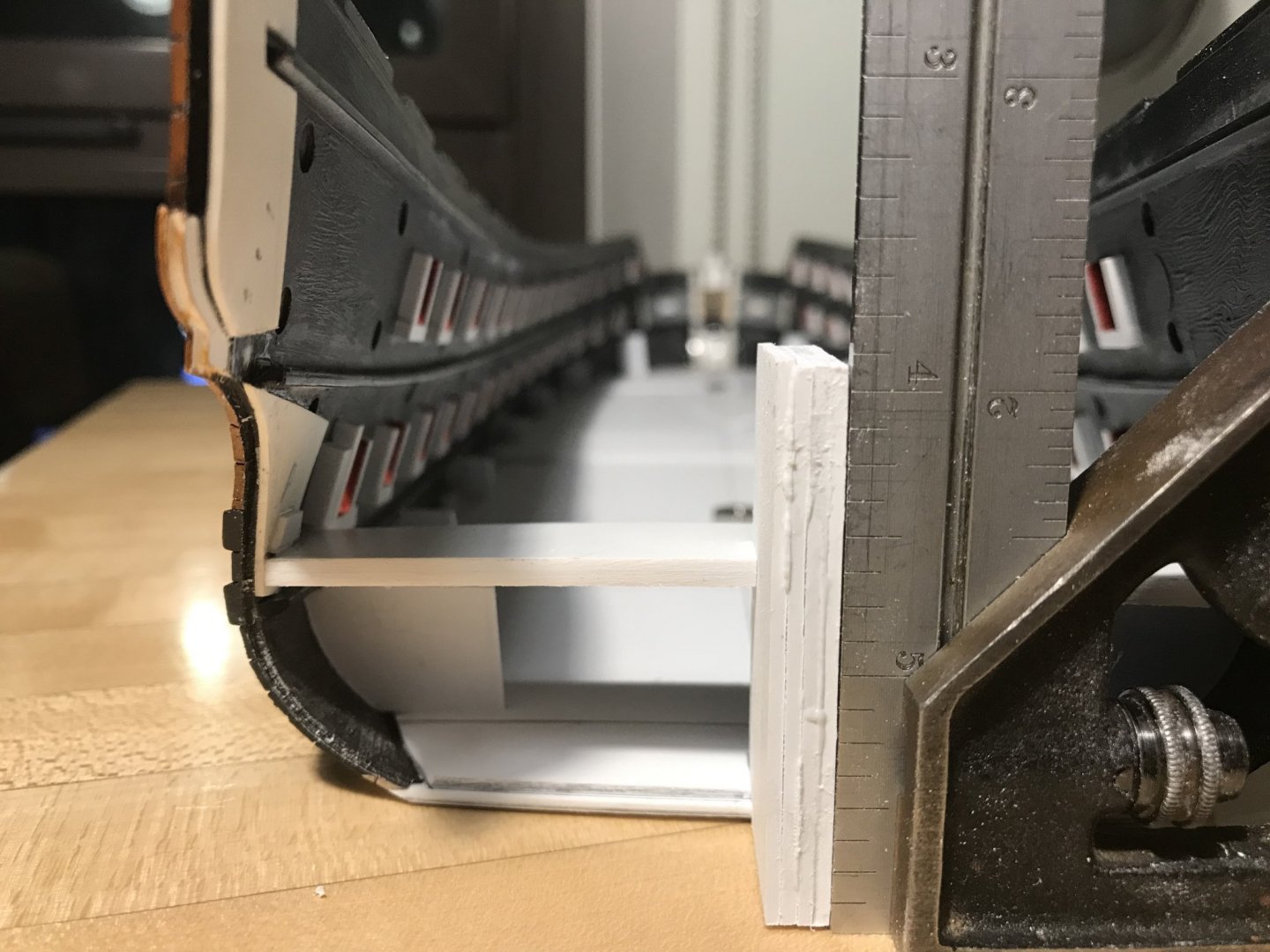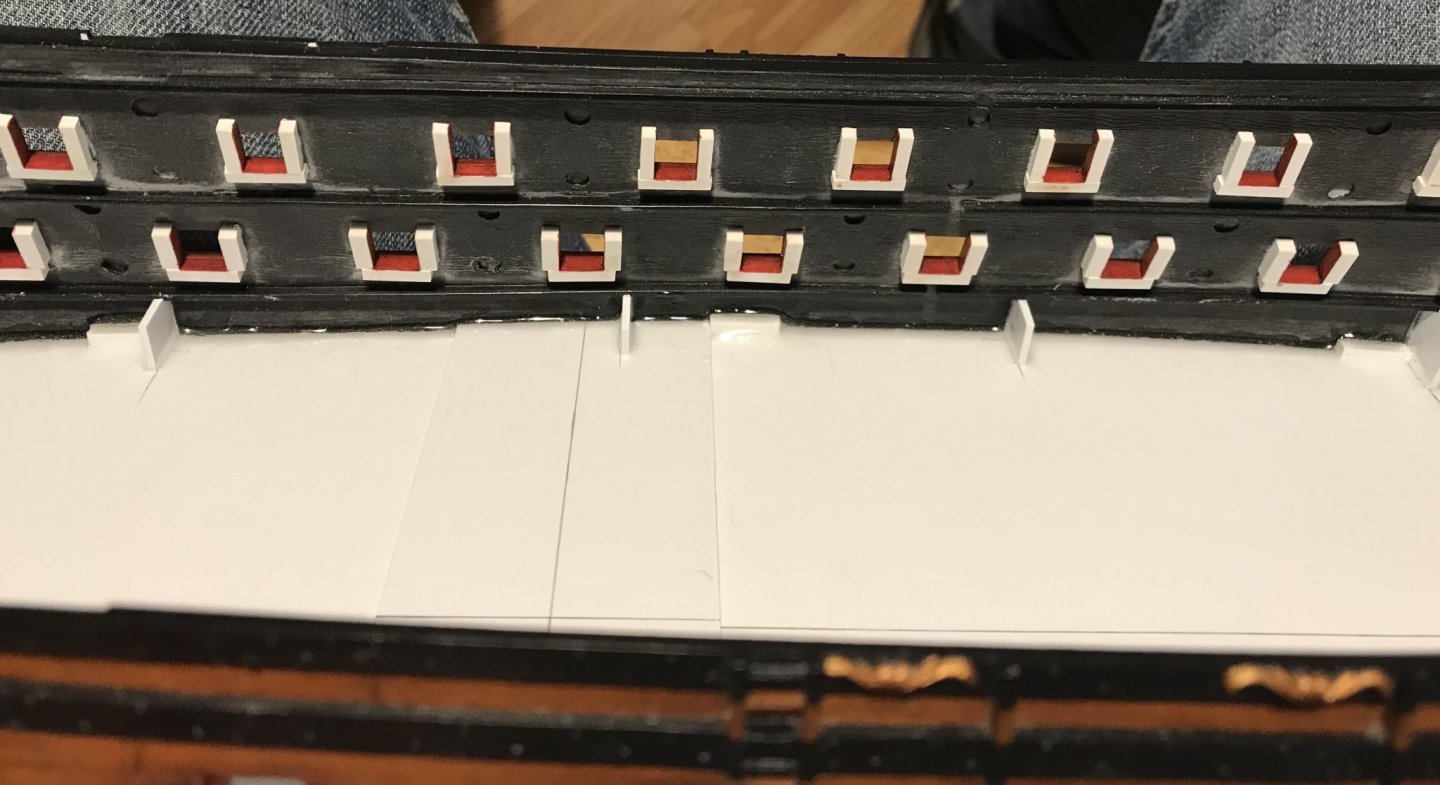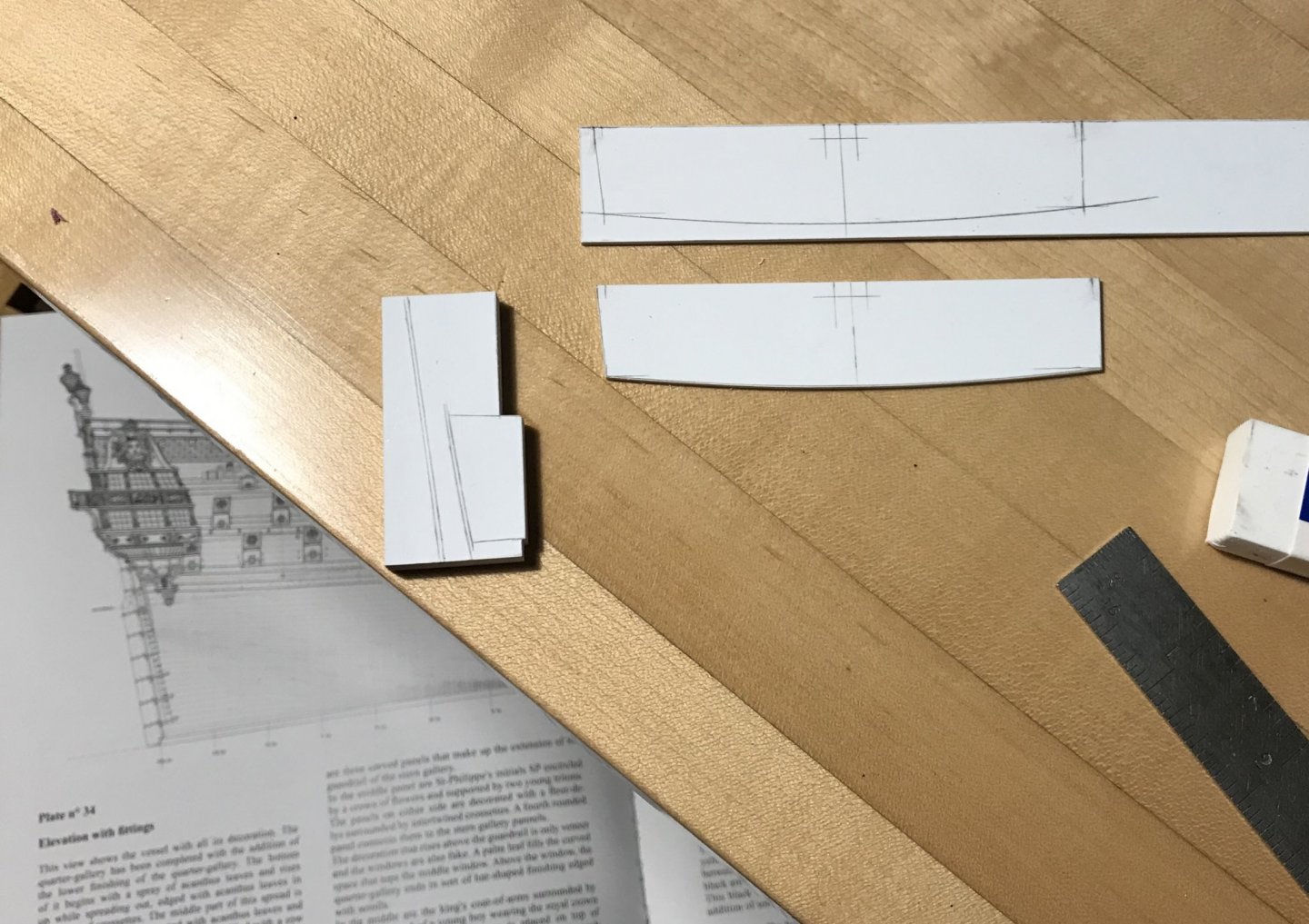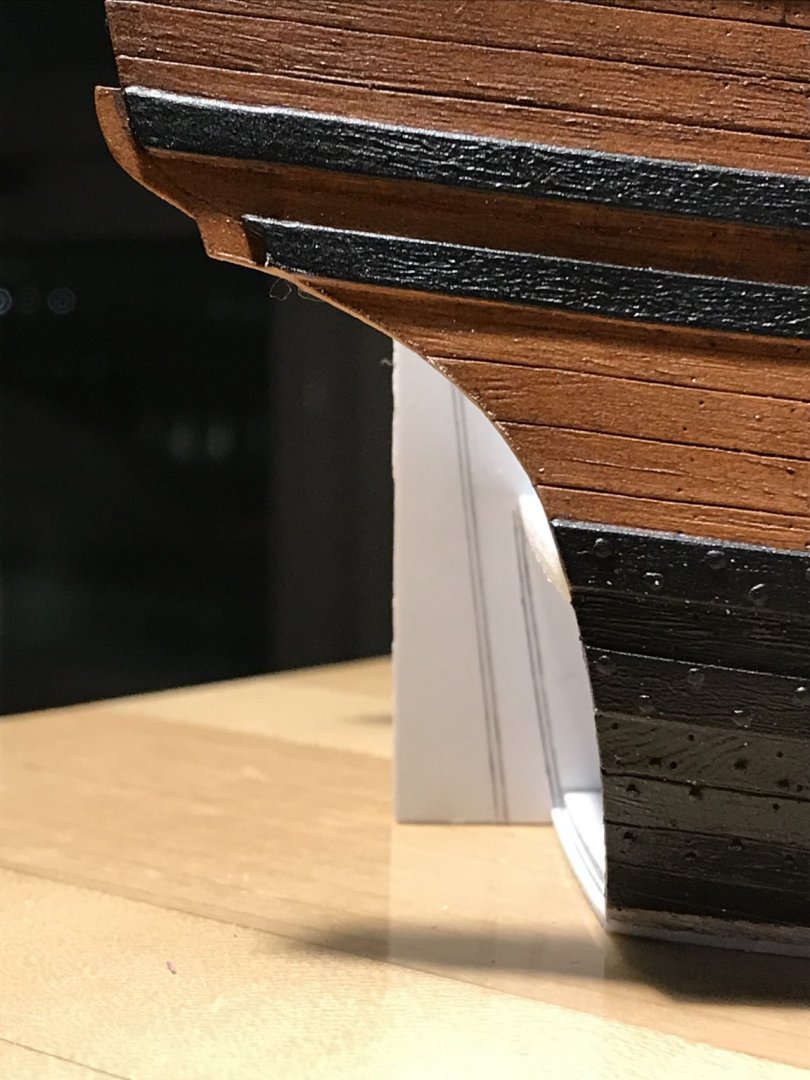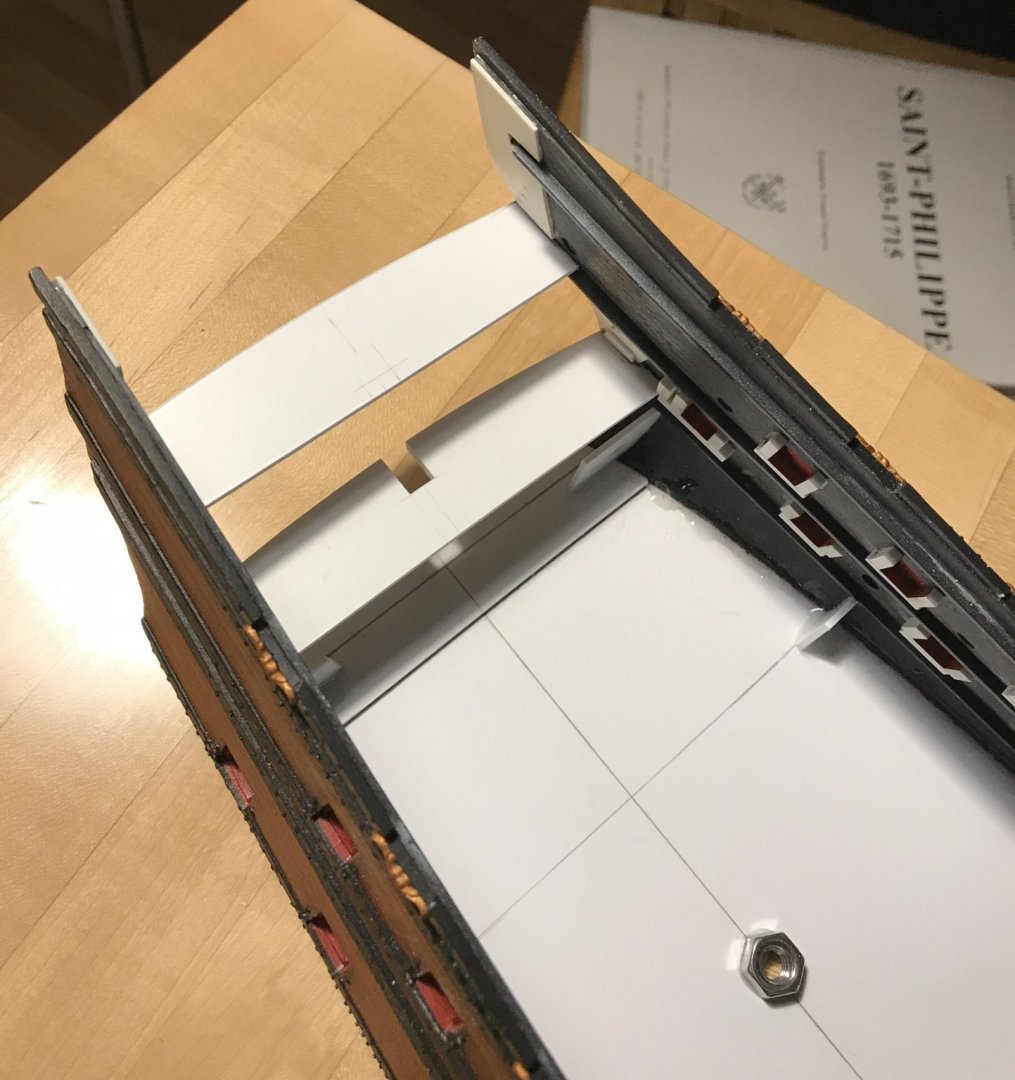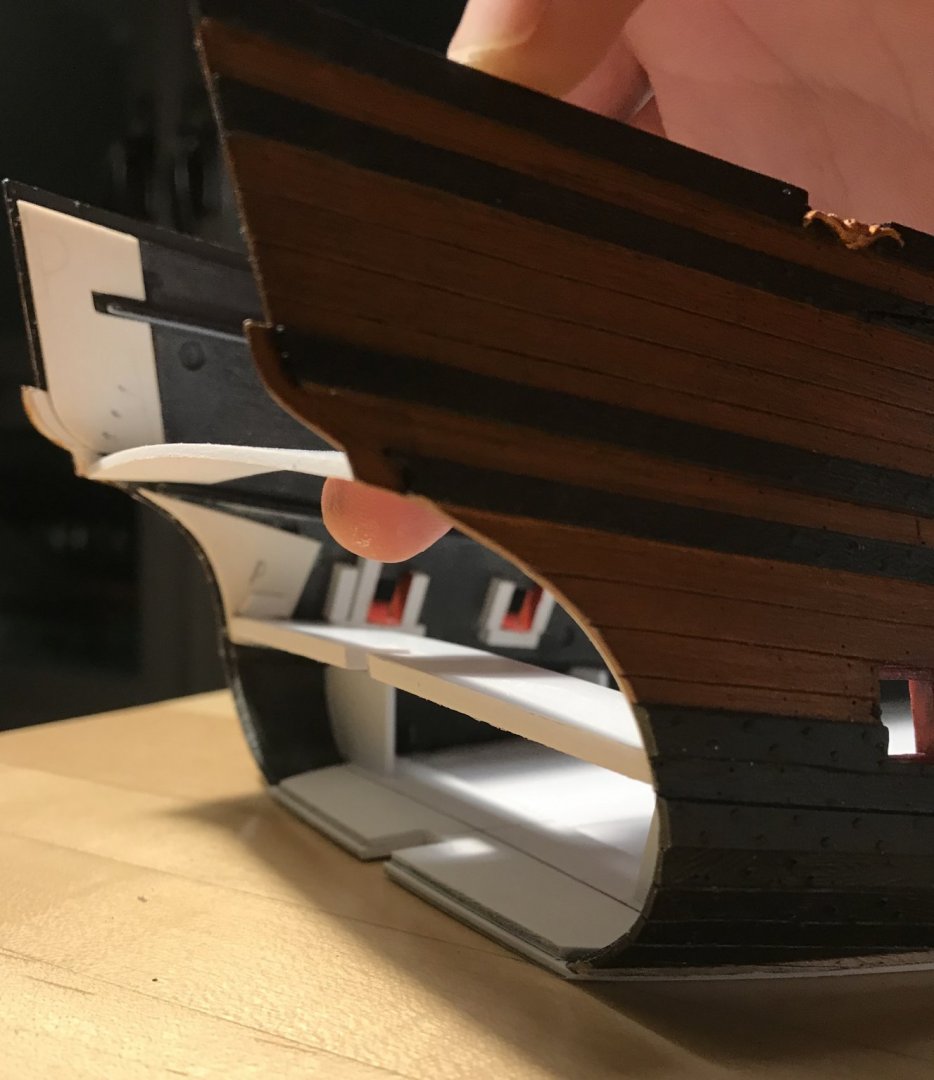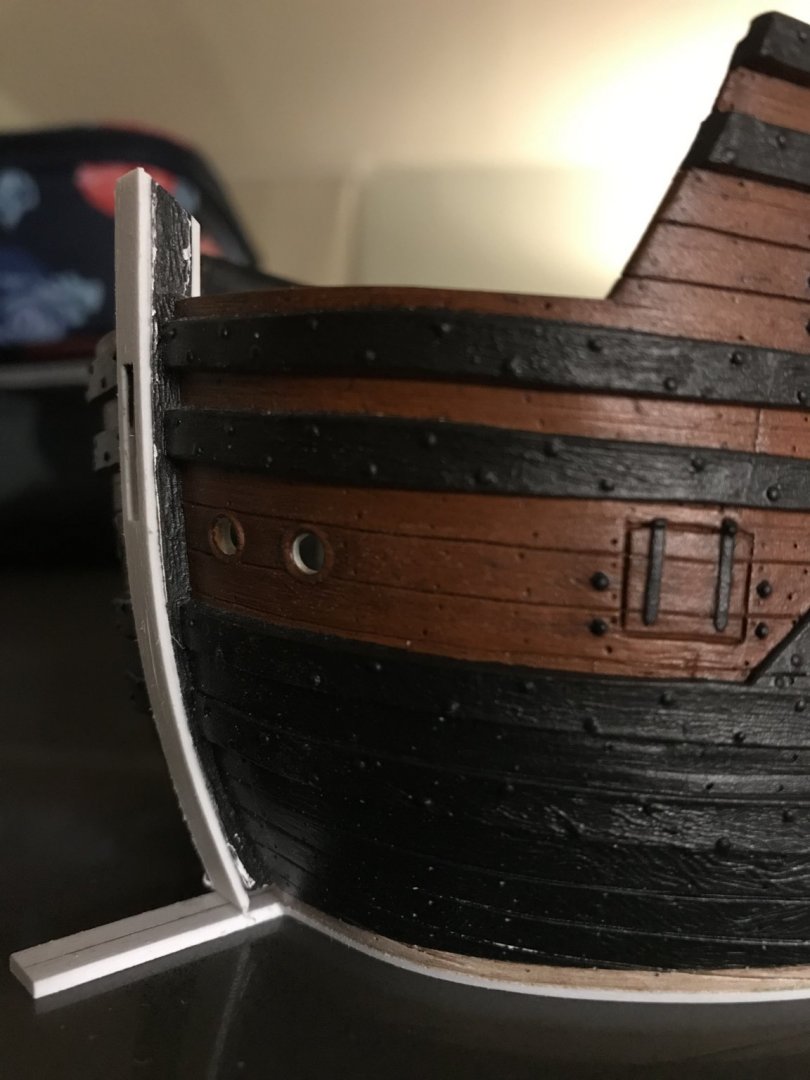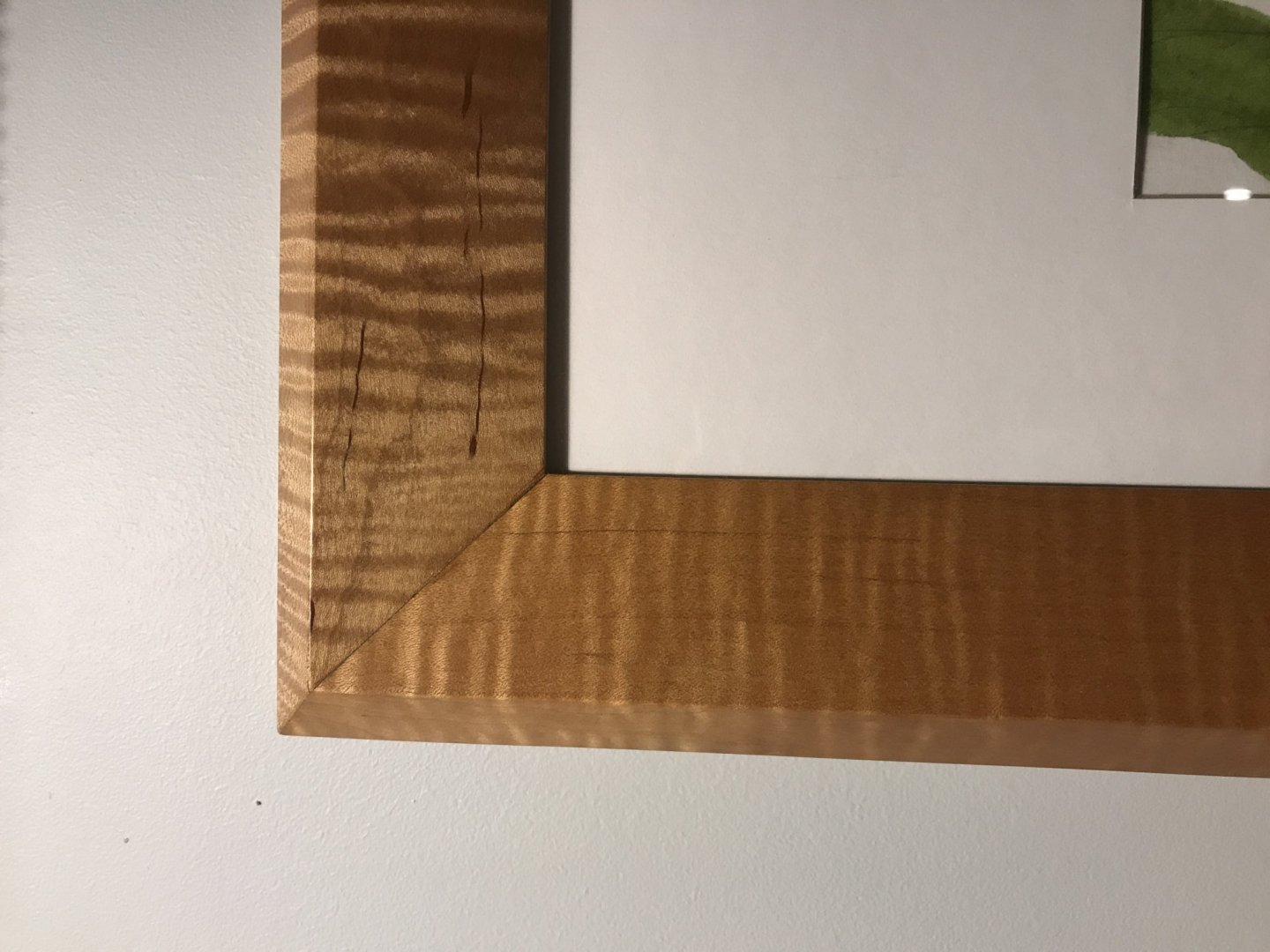-
Posts
3,292 -
Joined
-
Last visited
Content Type
Profiles
Forums
Gallery
Events
Everything posted by Hubac's Historian
-
Dan, you will be first with a complementary copy - signed first edition! Mike - thank you for the kind words. Personally, though, I would hesitate to place my project in the realm of any of the MSW superstars (Amalio, Mark Tiedens, Druxey, Chuck, Kudin, among many others); their research is much better grounded in historic fact, while much of what I’m doing is merely an educated guess. I certainly appreciate the compliment, though.
- 2,696 replies
-
- heller
- soleil royal
-
(and 9 more)
Tagged with:
-
Druxey and EJ - thank you very much! I suppose that if I hadn’t cut away the lower hull, there wouldn’t be as much necessity for custom framing. On the other hand, representing the closed-in, “false” lower stern balcony, as well as the stern round-up kind of necessitated it. In any case, I am having fun playing with the boundaries of what can be done with a plastic kit. I view this model as a great introduction to scratch-building. There have been numerous opportunities to develop new skills. At some point, I do plan to start printing out the build-log. There are specific blocks of research that would help make up the substance of my proposed book. Whenever I do get around to printing it, I’ll make you a copy, as long as you cover the costs for paper and postage. It is gratifying to me that you have found this information to be of use. The Gilded Ghost, on the other hand, would have very little to do with this model that I am making now. It would be a conjectural monograph that attempts to resurrect the early bones of Soleil Royal on the basis of her known dimensions, and what is understood about her better documented contemporaries - particularly Brest-built ships by Laurent Hubac. My operating theory is that early SR looked very similar, structurally, to the Monarque and the Royal Louis, but that the stern allegory would have largely resembled Berain’s designs, while the bulwark friezes would have been more specific to the profusion of heraldic ornament that is seen so clearly on the Monarque and the latter Dauphin Royal drawing. In my mind’s eye, what all of that would actually look like becomes clearer, by the day. Several people have already produced credible hull forms for first-rates, of this period. I would never be able to definitively say that this is what she looked like, but I believe I could make a plausible argument for my case. Anyway, locating that portrait would go a long way towards propelling that project forward. As always, thank you to everyone for your likes, comments and looking in!
- 2,696 replies
-
- heller
- soleil royal
-
(and 9 more)
Tagged with:
-
- 2,696 replies
-
- heller
- soleil royal
-
(and 9 more)
Tagged with:
-
Oh, interesting. I had so many problems with this post, this morning. Initially, it seemed to want to embed a video file, when I hadn’t even uploaded a video. so I copied and pasted the text into a word doc, and cleared the editor. When I pasted back into MSW, the pictures showed up again (at least on my screen), and I was able to save the post. When I get home, in a while, I do just a picture post for anyone else having similar issues. I love this forum, but the site is awfully wonky at times. Thanks for letting me know, guys!
- 2,696 replies
-
- heller
- soleil royal
-
(and 9 more)
Tagged with:
-
The framing of the stern continues in this installment, up to the stern counter. Initially, the process was identical to what I did below. The key difference was that I had to space my bulkhead framing to accommodate the placement of the stern chase ports. My initial layouts had the chase ports too close together and too close to the stern post. Eventually, I settled on the following layout: BTW, I have found my plywood build-board to be a great help in freeing up both hands for fitting and eventually painting. I can clench the board between my knees, with the bow end resting on the floor, and it is quite comfortable to work. This will be critically important when it comes to painting the stern. The board also keeps my grubby hands off the paint 😀 The location of the ports is hash-marked in pencil on the transverse round-up formers. I got lucky, in that I did not actively consider the fact that there are caryatid carvings, between the chase ports, whose placement must align between the 1st/2nd & 5th/6th stern windows. Directly above these caryatid carvings are the middle balcony supporting figures of Spring and Summer; if all of these carvings do not align properly, then the finished result will destroy the harmony of Berain’s design. Anyway, as I had only realized this, after I had glued-in all of the bulkhead formers, I am very glad that I didn’t have to cut the whole lot out and start over, again. I thought I might be able to simplify waste-removal if I made stock for the port sills and headers that followed the transverse curve of the round-up: I glued in the sills by eye, adjusting them for level. I then made a 5/16 spacer block to mark the parallel location of the headers. The resulting ports appear taller than they are wide, but this is merely an optical illusion; the openings are 5/16” square, just like the broadside ports: Above, you can see that I used a coarse drum sanding attachment in the Dremmel to rough back the starboard side. I don’t think I really saved myself any time, as I still needed to do quite a bit of fairing-in by hand to get the sills to follow the compound curvature of the stern counter. Additionally, their in-board profile was not as perfectly symmetrical as I had hoped, but it won’t matter in the end. After painting, there will still be a sense of the transom being bolstered by its internal structure. The ports and bulkheads faired: You may notice a partial doubling of the bulkhead formers at the top of the stern post. This was to accommodate the cutting-in of the “jaumiere” opening for the rudder head. The stock Heller transom plate shows the juncture of two angled, straight lines, extending out from the stern post, and intersecting with a shallow arc. All of the best Arsenal models I have observed show a softer, almost heart-shaped opening. This remains a work in process, but the starboard side reflects the finished shape I will match to, on the port side: I now have a fair surface that I can plank to. I will begin by establishing the lowest horizontal plank that nibs beneath the sills of the chase ports. Below that, I will establish the herringbone angle of the planks for the lower transom. Following all of that, I will create the ornamental transom wale, as well as my addition by authorial license: a flowing, carved banner (like the Provincien name banner) that is inscribed with what could be considered the motto of Louis XIV NEC PLURIBUS IMPAR Roughly translated, this means: not un-equal to the illumination of many [suns]. Well, while I am very happy with the process, so far, this is a long and winding road. Sometimes I like to daydream about where all of this is going: Maybe today, my latest title will arrive. After struggling mightily through Uber Den Wellen, I went ahead and ordered another German language book: Versailles Der Meere. The author beat me to the title, so I am eager to learn what he has to say... if I can translate it. Perhaps the author will have located a better image of my Gilded Ghost. Oh wait a minute - that sounds as though it could be the title of an, as yet, unwritten book: The Gilded Ghost: A Forensic Reconstruction of Laurent Hubac’s Soleil Royal, 1670 ©️by Marc LaGuardia Now the title’s mine 😉
- 2,696 replies
-
- heller
- soleil royal
-
(and 9 more)
Tagged with:
-
My book recommendation would be: Les Trois-Ponts du Chevalier de Tourville, 1680. Although La Belle represents the smallest of armed vessels - the barque longue - she is a microcosm (IMO) of all of the larger ships of the line, from this time period. From a general construction standpoint - what applies to the big ships, would mostly also apply to the smaller ships.
-
Marc - happy to see you back! Vermeer could not do a better job of imparting realistic flesh tones. All of that is impressive. However... How’s’bout a few more broad photos of all of the planking work you have been doing 😀 Can we see some more of that, s’il vous plait?
- 208 replies
-
- le soleil royal
- 104 guns
-
(and 2 more)
Tagged with:
-
I remember this kit well from the ModelExpo catalogs, in the 80’s. I always liked the model and thought Amati did a decent job of representing the ship. You make an interesting point about the number of bulkheads; that should make for a more fair hull. One thing you might consider - because I think it can he done convincingly without having to alter anything else - is to modify the profile of the cutwater; Amati represents a more curved shape, but in reality, English ships of the period would have had a cutwater that was a straight line from the turn of the figurehead to the footing of the stem. It will look great, either way, but it is something to think about. You are off to a great start, and I will gladly follow along!
-
Oh, cool. Well, if you haven’t already - check out md1400’s build of the Corel version; he really did so much to make the model more authentic. A lot of really good ideas there.
-
I’m sorry to hear about the loss of your Dad. We lost my mom 3 1/2 years ago, and my father has long out-lived anyone from his side of the family. Nevertheless, at 85, he soldiers on and we are lucky to still have him. I wish you healing and fond memories as your family grieves his loss. The model looks spectacular, by the way.
- 510 replies
-
- reale de france
- corel
-
(and 1 more)
Tagged with:
-
Are you familiar with this builder? http://olivier.gatine.free.fr/og/index.html His model of La Belle is, in my opinion, just one of the cleanest, most elegant, and most superbly carved models I have seen. Olivier really captures the elan of French design. He is an inspiration to me, and whenever it is that I am equipped to build my first Arsenal style model, La Belle will be the subject; she’s the perfect microcosm of French naval architecture from this period that interests me the most. The model you are making is on track to be every bit as good. I am following your resourceful methods with great interest.
-
Thank you Chapman and Druxey, and thank you to everyone for the likes and looking in. It is all very much appreciated!
- 2,696 replies
-
- heller
- soleil royal
-
(and 9 more)
Tagged with:
-
The lower transom bulkheads are all in and faired. All but two of the lower deck beams are in. I wanted to install the lateral round-up former at the counter level, however, I realized that I should first make a pattern of the interior planking rabbet, as the vertical bulkheads would need to match this shape. With a piece of green tape abutting the wing transom former (in the hope that I could simultaneously establish the bottom angle of the fashion pieces), I took a tracing of the planking rabbet: With drawing curves, I established a fair line, and I also marked the inboard and outboard boundaries of the lateral formers so that I knew how deep the cantilever of these counter bulkheads needed to be. After connecting all the dots, this is the over-tall pattern that I arrived at: I cut close to my lines and then tested the pattern at various points along the wing transom. On the starboard side, from which I established the pattern, agreement between the bulkhead former and the outboard profile of the fashion pieces was very nearly identical. However, as I moved the bulkhead pattern across the wing transom to the port side, it became visually apparent that the shape of the port side fashion piece was a different, more compressed arc. The question became just how much these two shapes differed, and what to do about it. Doing nothing would result in an unfair and awkward run of the planking as it seated on the port side. Creating two different patterns that converged toward the centerline did not seem like a better approach. This difference was difficult to ascertain, concretely, by eyeballing the bulkhead pattern as I shifted it slightly inboard or outboard, relative to the fashion pieces. It dawned on me, though, that I could make a “negative space” pattern from the bulkhead former and then offer that up directly to the fashion piece profile. Above, on the starboard side, the match is nearly perfect. However, on the port side, I could now clearly see the variance: I could also, now, use my negative pattern to trace a new line over the top end of the fashion piece, just beneath where the stern counter rises: With that sorted out, it became a simple matter of reshaping the outboard profile, in order to achieve a perfect match between starboard and port. This same principal could then be applied to the planking rabbet, in order to ensure that the rabbet was a consistent depth, all along: This new reference line showed me exactly how much higher I now needed to set the counter former on the port side: By this point, I was getting too tired to reliably do the actual fitting, so I left off here. After making these adjustments, though, I should be able to glue in the counter former and use one bulkhead pattern to frame-in this space.
- 2,696 replies
-
- heller
- soleil royal
-
(and 9 more)
Tagged with:
-
Work continues. I have profiled the stern post, which to the best of my knowledge, is not tapered. The aft edge of the rudder, on the other hand, has a definite taper that increases below the waterline. I installed the aft-most lower deck beam because the transom bulkheads would soon make this area in-accessible. These lower decks have no camber, so the beam tops are set flush with the top edge of the pre-moulded deck ledge. The doubled construction will give plenty of support and glue surface to the lower decks, and they continue at regularly spaced intervals. The vertical round-up is based on one curved pattern that begins at the point of greatest height - adjacent to the stern post - and carries through to the hull sides. As with the gussets, great care was taken to ensure good mating joints. Spacing between transom bulkheads is 3/8”. While I pre-beveled the bulkheads, prior to installation, I fair those bevels once the glue has set to ensure that I remain within my planking rabbet at the base and along the hull sides. Following is a photo montage of variable quality, that will give a better sense for what this looks like: It annoys me a little bit that the glue I paid along the joint sides isn’t neater, but it really won’t matter one bit because you will never see it. I will also glass-in the principal structural elements with epoxy, anyway. After a nice visit with my father, this weekend, I brought home the remaining guns and their carriages. Work has already begun to clean and assemble those parts. These are the quarter, f’ocsle, and poop deck guns, which will all be super-detailed, as before. I also brought home the lower mast sections, which will be reinforced with birch dowel. With the main mast, I can now step its footing and establish the rake. I also plan to make new tops of a somewhat broader diameter, so that the topmast ratlines have a more convincing spread, or slope. That’s another good small-work project for my downtime.
- 2,696 replies
-
- heller
- soleil royal
-
(and 9 more)
Tagged with:
-
That is such a cool little detail! Thanks for sharing.
- 1,784 replies
-
- winchelsea
- Syren Ship Model Company
-
(and 1 more)
Tagged with:
-
Hi Chuck - incredible job, so far! My question is more a point of curiosity: I noticed that as your garboard strake runs aft, close to the stern post, there’s a slightly stepped transition from one plank width to the last more narrow plank section that runs into the stern post. This appears very deliberate, and I was wondering whether it had something to do with the rabbet.
- 1,784 replies
-
- winchelsea
- Syren Ship Model Company
-
(and 1 more)
Tagged with:
-
It’s been a solid week in my dry-dock. I decided, after all, to fir-out the stem piece, and now - short of a Battle with Bar Floor, as Popeye2Sea once funnily quipped - there should be little chance of my bow crumbling. I also added a series of tabs 1/8”x1/8”, along the hull/base joint before glassing the whole thing over with epoxy. So, now I could turn my attention to the fully scratch-built component of this project - the stern. Earlier, I had created an over-wide pattern for the lateral/outboard (port to starboard) curve of the round-up, but I also needed to create an over-wide pattern for the upward-arching camber of the round-up, as round-up is a combination of these two curvatures. For this camber pattern, I used the bottom edge of the stock kit stern plate to establish the line. This is necessary because I will be extracting the stock stern windows from this plate and heat-bending them to conform to the lateral round-up. I’m always looking to recycle what I can, so I suppose the stern isn’t “completely” scratch. For my immediate needs, though, I duplicated the camber pattern and made a glueing fixture with a 1/4” separation between the two curves. The reason for that is that I am laminating 2, 1/16” pieces of sheet styrene to form lateral framing ties that bridge the transom, and tie the whole model together. The first of these, above the base plate, is in the position of what would be the wing transom of a traditionally framed ship. For the sake of all SR nerds out there (like me 🤓), I will note that the Tanneron/Heller positioning of the wing transom is below the stern chase ports - as popularly became the French practice after 1672?/73; the actual first SR had a wing transom that remained above the chase ports, even after the re-build of 1689 - if the Berain stern drawing is to be interpreted as a literal document of the ship’s actual framing. So, for this model, I set to work patterning my “wing transom” below the ports. In order to make reasonably accurate measurements, inside the hull, I cut two strips of scrap styrene so that they were each about an inch longer than the centerline. I cut points on one end if each strip, and then I lapped the strips and extended those points to both the outboard and inboard spans that I was trying to measure. Once I made contact, at each end, I marked the overlap of the strips with a sharp pencil, so that I could then measure that against my ruler. One picture would have explained all of that very succinctly, but I failed to take that picture😔 Anyway, after a fair amount of fitting, I got one lamination pretty close to the right fit (without spreading the upper span of the stern more than I wanted), and then used that first piece to mark out and cut the second lamination. Factored into the layout of these pieces is an extra 1/32” of an inch, beyond the straight span, so that the piece will still fit snuggly after the camber is induced. After spreading plenty of styrene adhesive, I taped the assembly into my camber jig and left it over-night. Although I was skeptical that such a shallow curve would impart much permanence to the cured assembly - there was virtually no spring-back: So, then, I did the final fitting (except for the stern post notch) and glued the wing transom in place. In order to make the glue-up easier to locate, I glued in positive stops (small trapezoidal tabs) just above each joint, in order to ensure that the WT lands between the two lower main wales, on each side. Tabs visible in pic, below; For the stern post, I laminated four pieces of 1/16” sheet into a 1” x 2” billet. It’s way over-size, but I wanted plenty of room to layout the vertical round-up of the lower transom and the corresponding rake of the stern post. After easing the plate notches to accommodate the stern post billet, I was pleased to see that the assembly had remained square. My plan for the stern post is that it will notch into and also support the wing transom from underneath, as a means of ensuring that the camber remains consistent throughout the construction process. In the next picture, you can see how the billet notches into and over the base plate and into and under the WT: Also pictured are the lateral blanks being made for the next level of the stern, at the level of the stern counter. For visual guidance, in laying out the vertical roundup, and the rake of the stern post, I referenced Lemineur’s monograph of the SP (visible on the chair): The curve of the round-up is pretty well proscribed between the outboard edge of the WT and the planking rabbet of the base plate. I had to re-draw the rake of the stern post several times in order to find the happy medium that looked appropriate, while helping to balance the somewhat exaggerated overhang of my stern counter: The outboard parallel line indicates the beveling of the stern post. The rudder, itself, will be a separate assembly, however, I am not concerned about that, at the moment. I will be, though, when I have to pierce the counter planking, in order to accommodate the rudder head - what the French call the “Jaumiere.” I’ll now need to profile the stern post. I’m not sure whether the stern post also receives a slight out-board taper, but I’ll investigate that. It may be possible for the sternpost to notch into and support the camber for the counter-spanning piece, which I have nearly completed fitting: Here, my finger induces the camber that the gluing fixture will soon impart: Once this second camber piece is glued in place, along with the stern post, I can frame in the vertical members that will make planking possible. Thank you to everyone for your likes, your comments and for looking in. Have a wonderful weekend!
- 2,696 replies
-
- heller
- soleil royal
-
(and 9 more)
Tagged with:
About us
Modelshipworld - Advancing Ship Modeling through Research
SSL Secured
Your security is important for us so this Website is SSL-Secured
NRG Mailing Address
Nautical Research Guild
237 South Lincoln Street
Westmont IL, 60559-1917
Model Ship World ® and the MSW logo are Registered Trademarks, and belong to the Nautical Research Guild (United States Patent and Trademark Office: No. 6,929,264 & No. 6,929,274, registered Dec. 20, 2022)
Helpful Links
About the NRG
If you enjoy building ship models that are historically accurate as well as beautiful, then The Nautical Research Guild (NRG) is just right for you.
The Guild is a non-profit educational organization whose mission is to “Advance Ship Modeling Through Research”. We provide support to our members in their efforts to raise the quality of their model ships.
The Nautical Research Guild has published our world-renowned quarterly magazine, The Nautical Research Journal, since 1955. The pages of the Journal are full of articles by accomplished ship modelers who show you how they create those exquisite details on their models, and by maritime historians who show you the correct details to build. The Journal is available in both print and digital editions. Go to the NRG web site (www.thenrg.org) to download a complimentary digital copy of the Journal. The NRG also publishes plan sets, books and compilations of back issues of the Journal and the former Ships in Scale and Model Ship Builder magazines.




